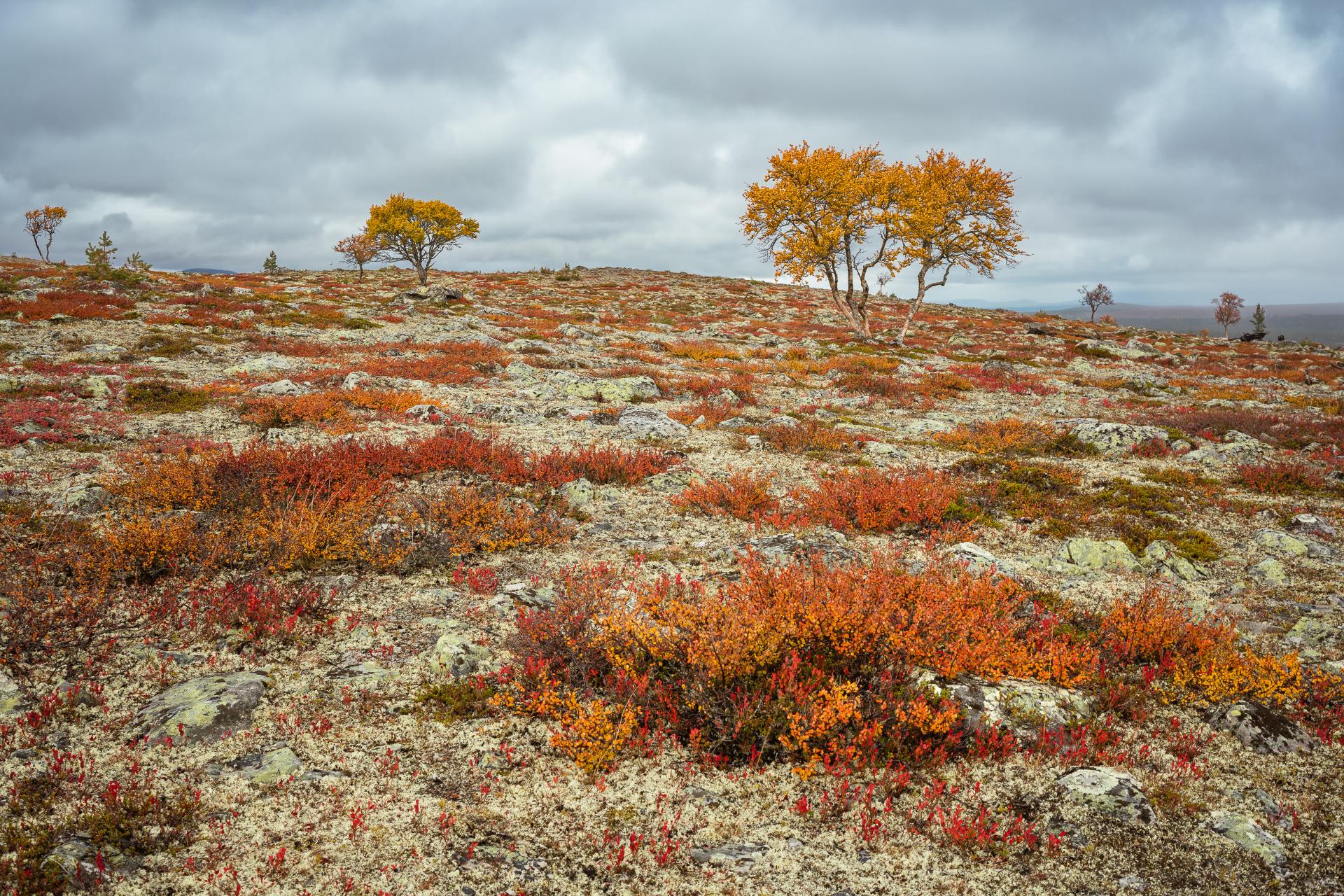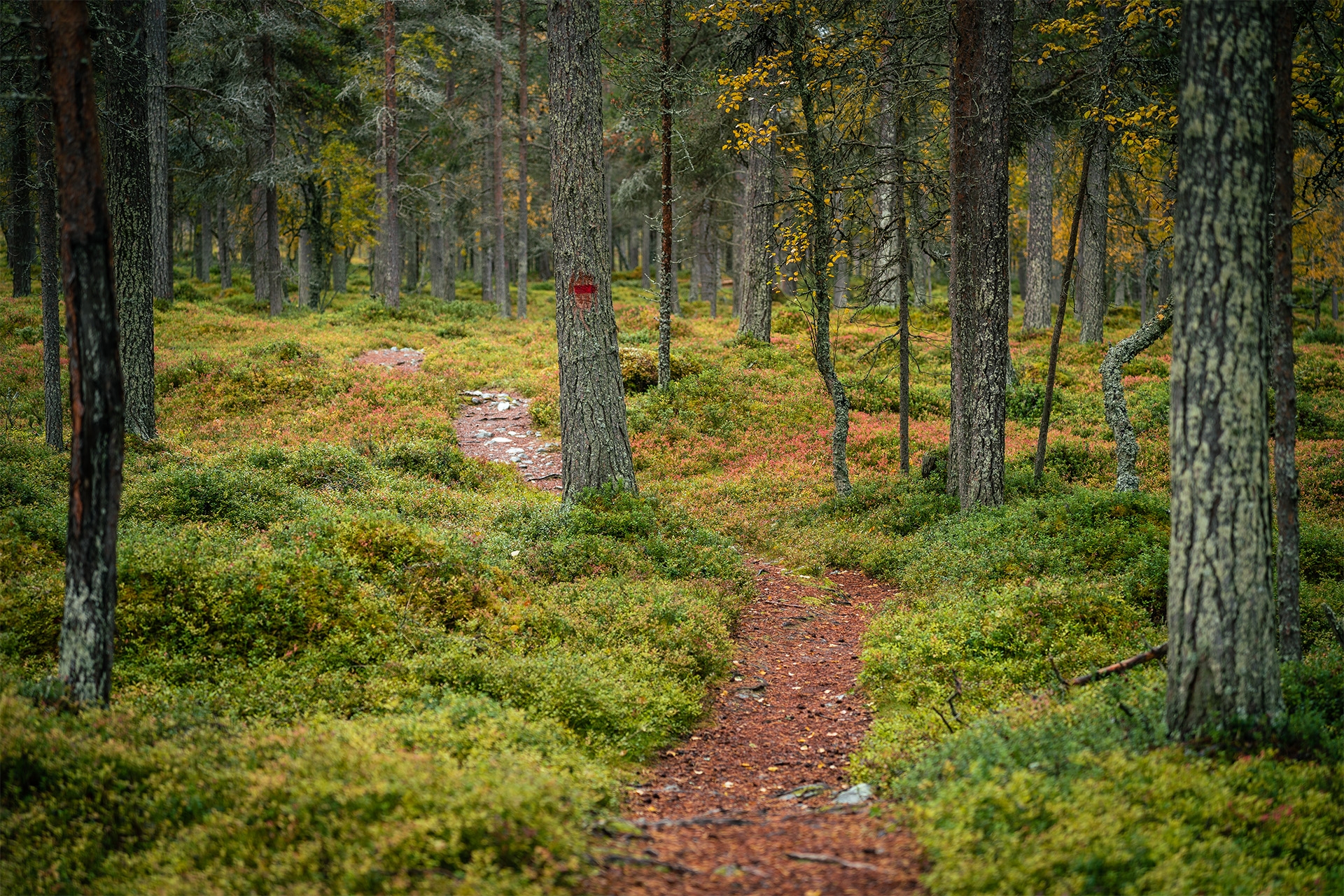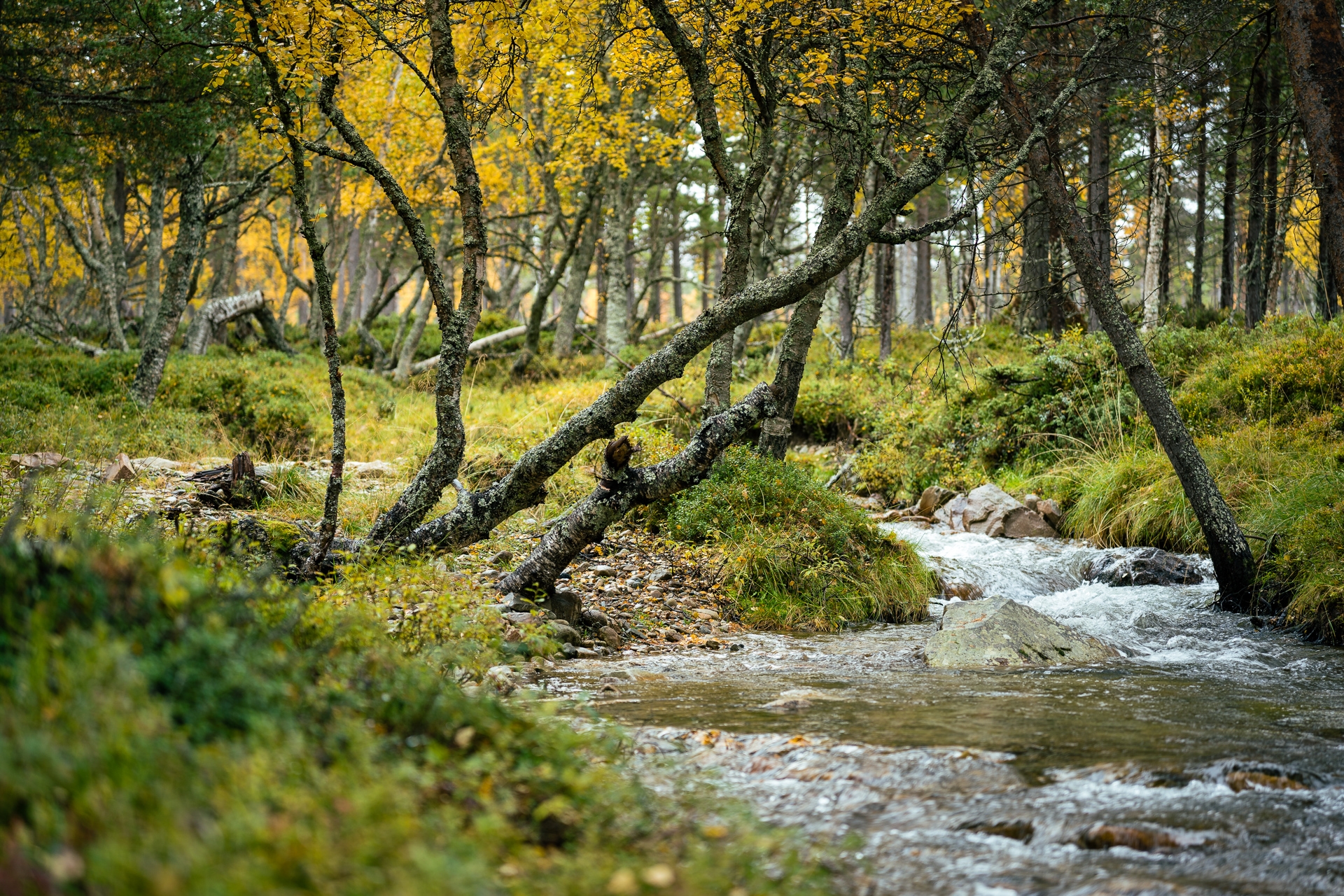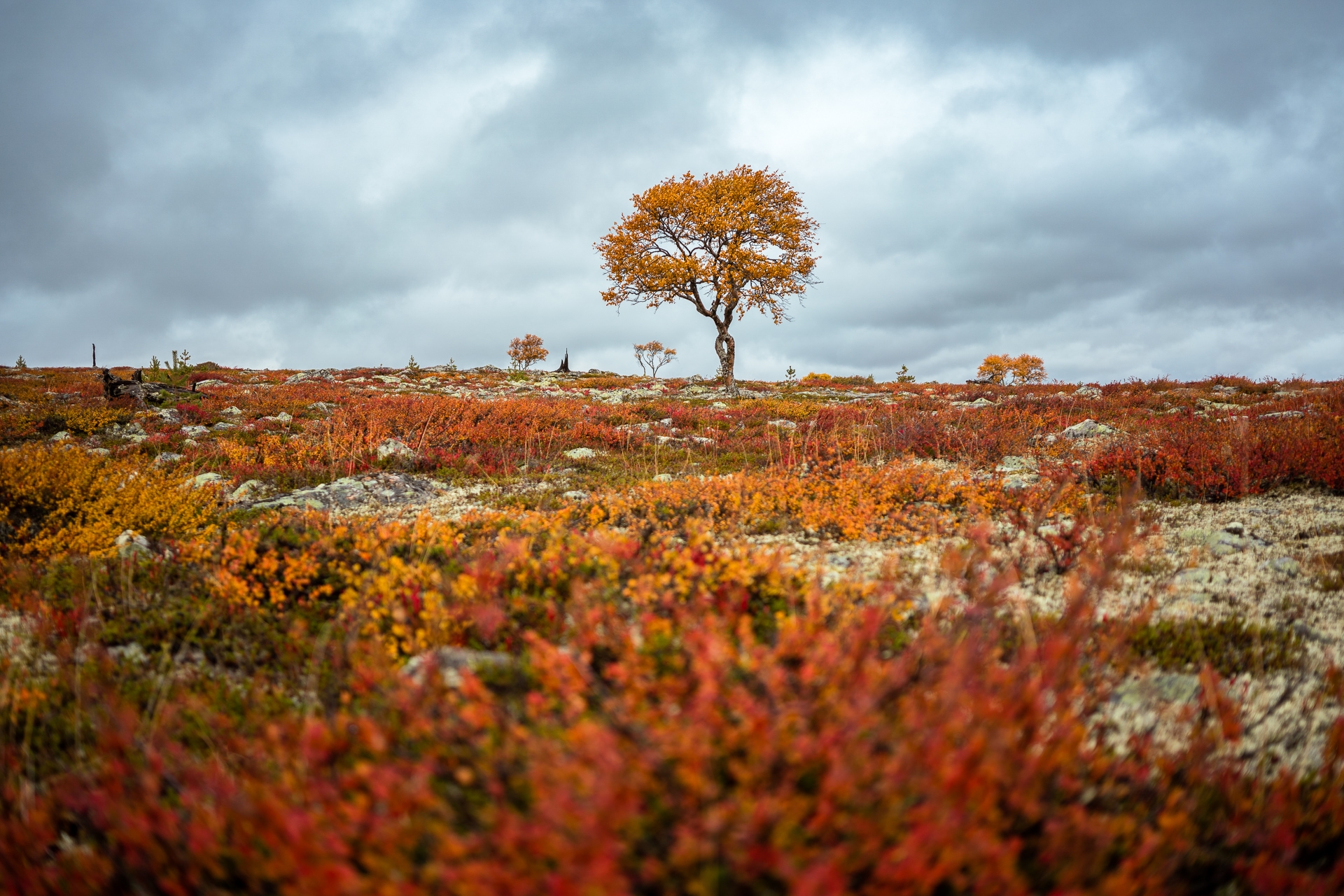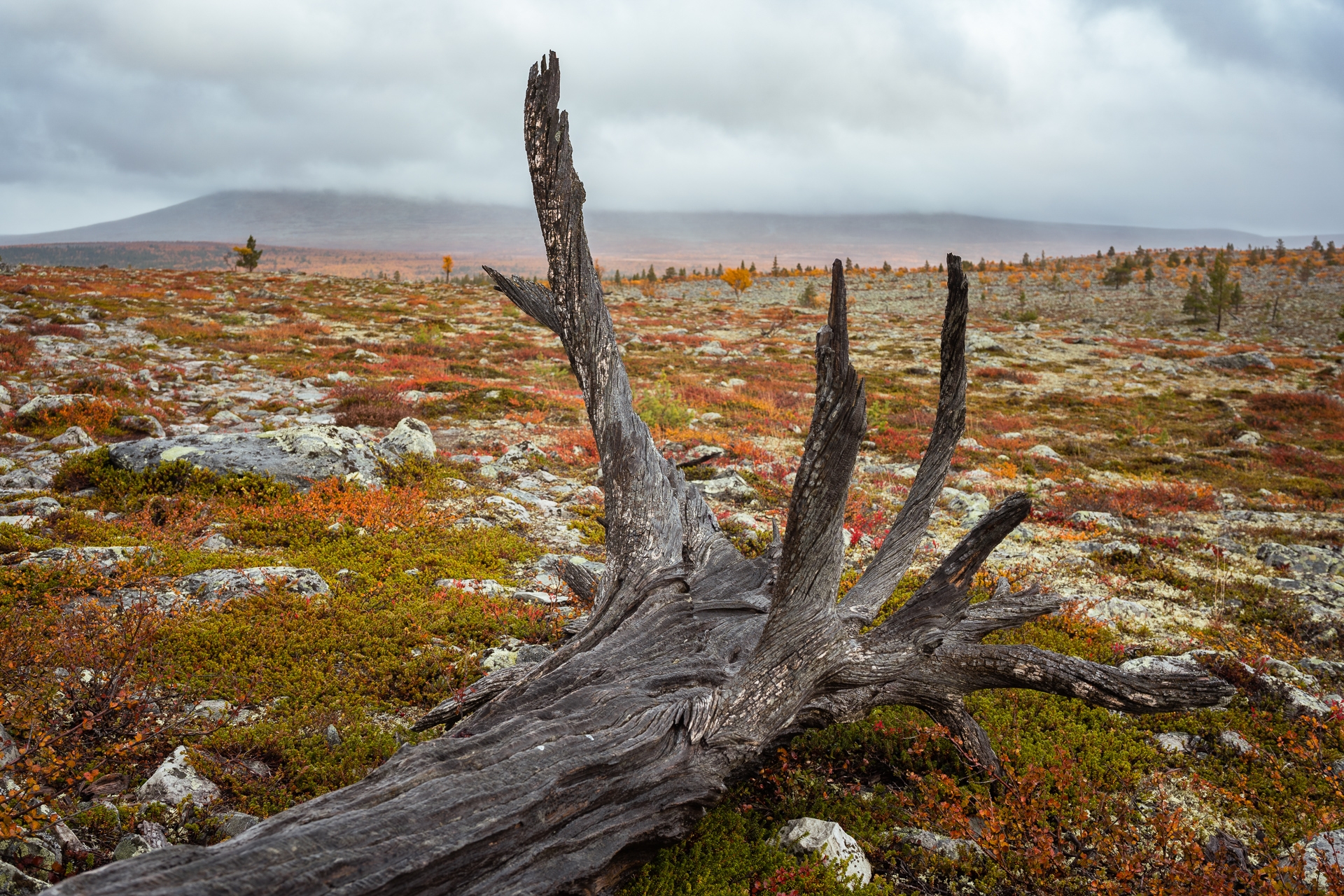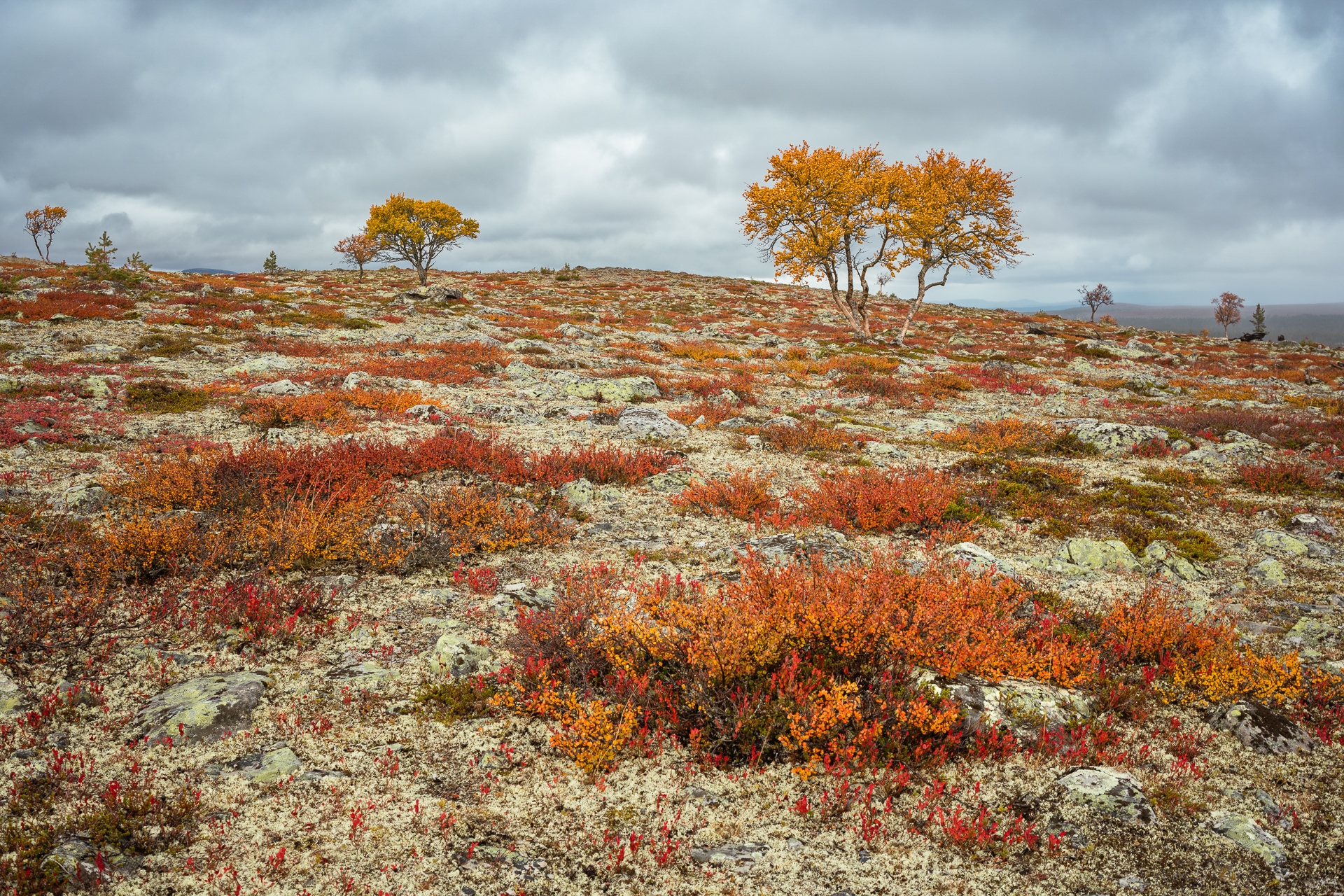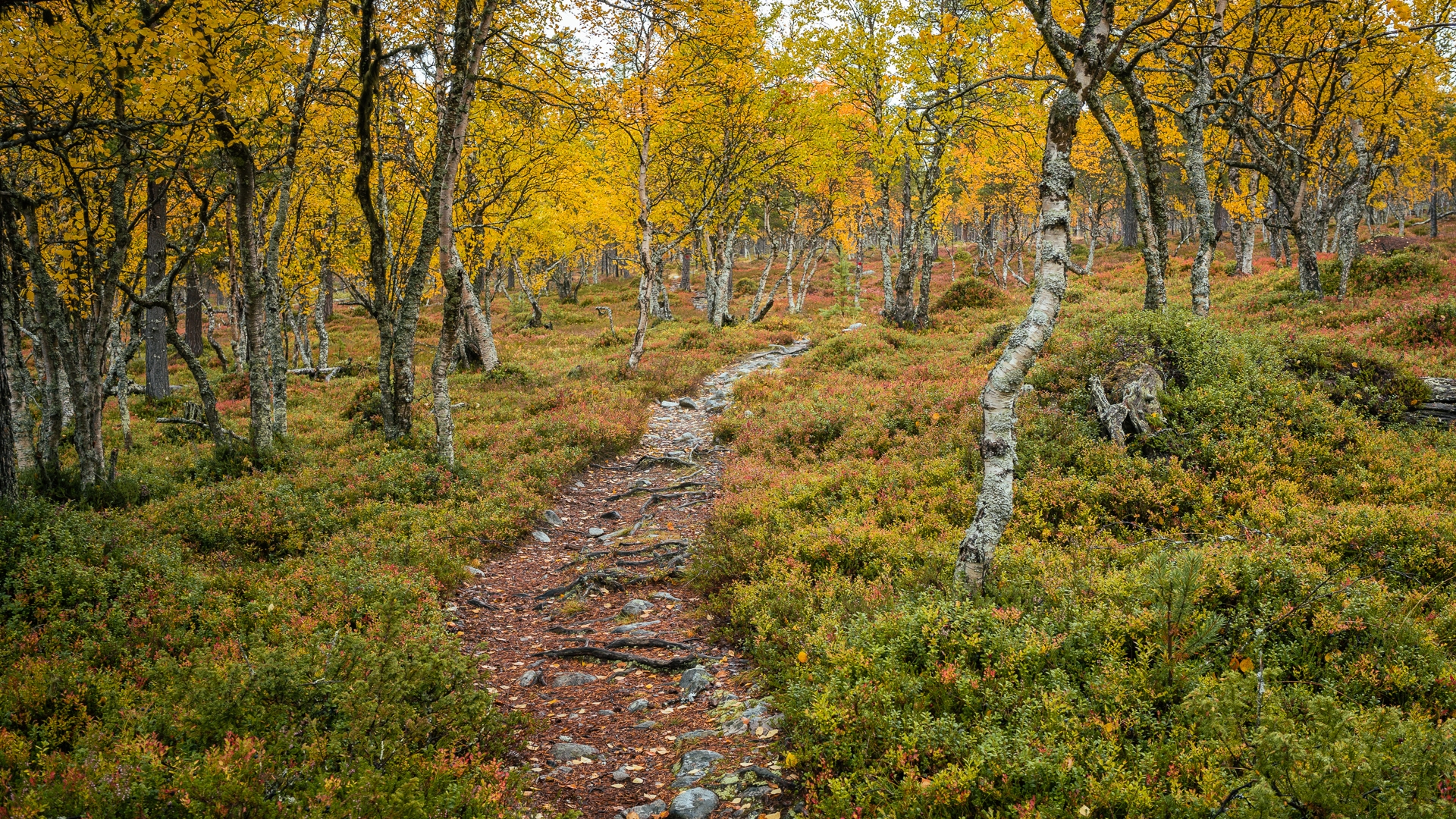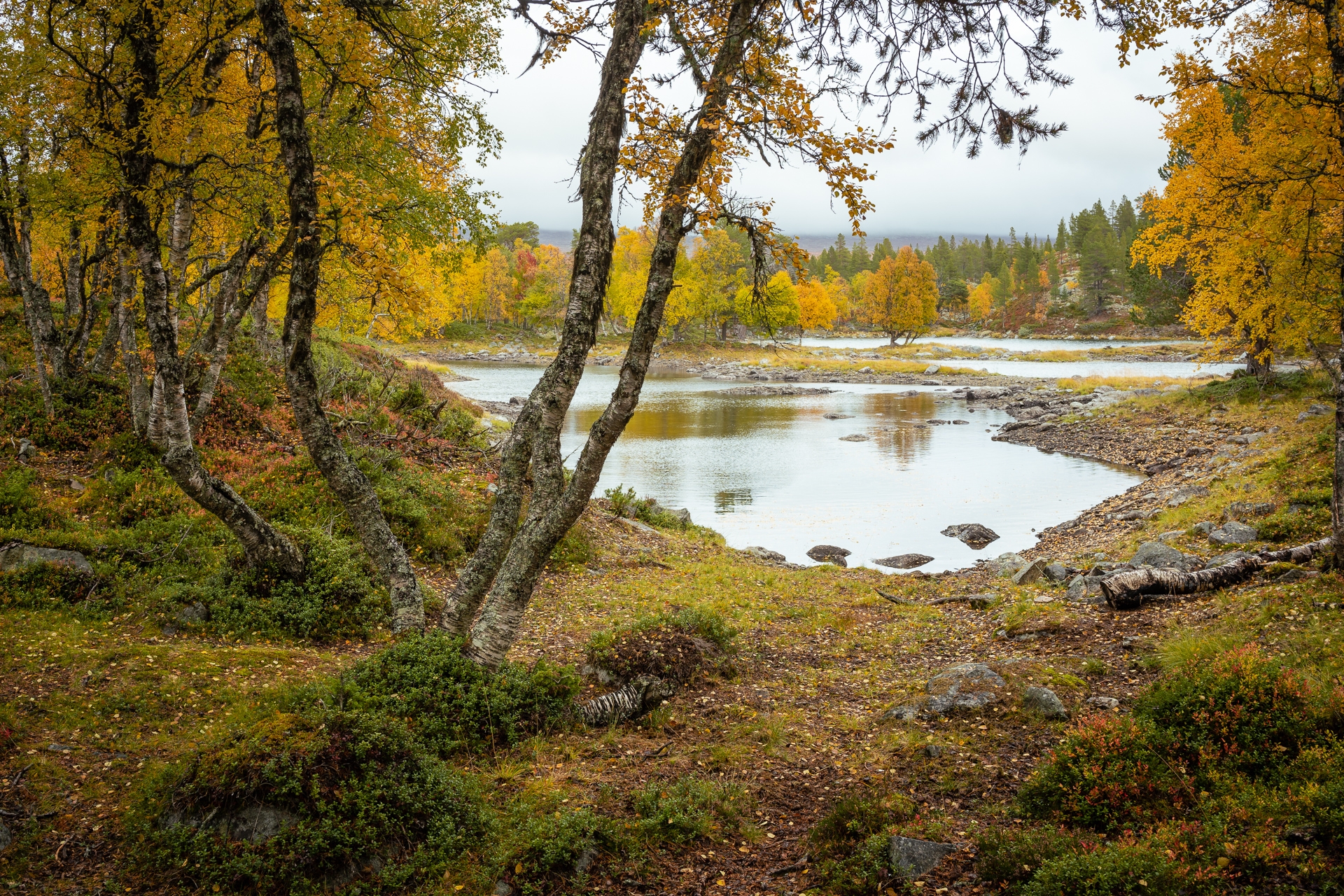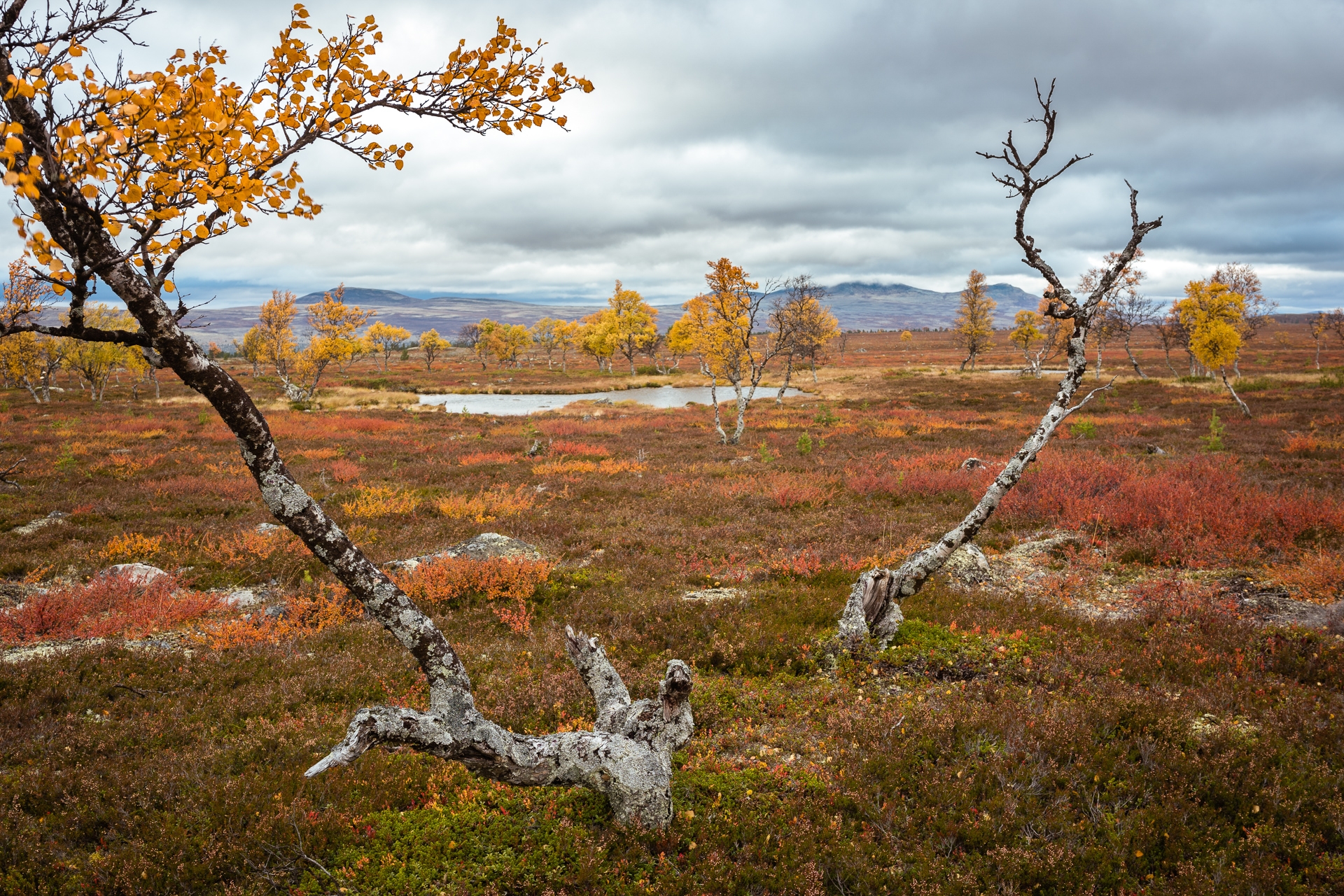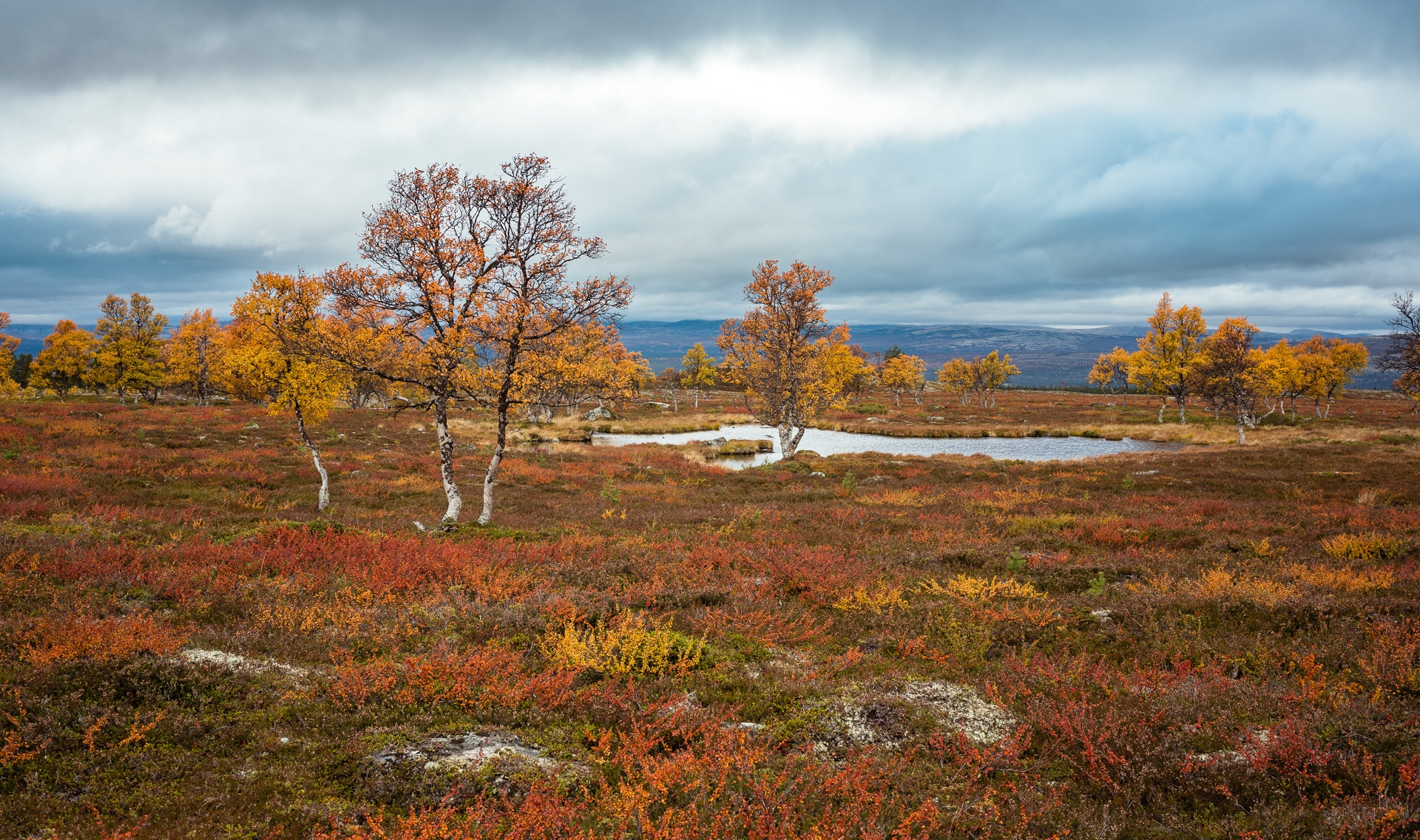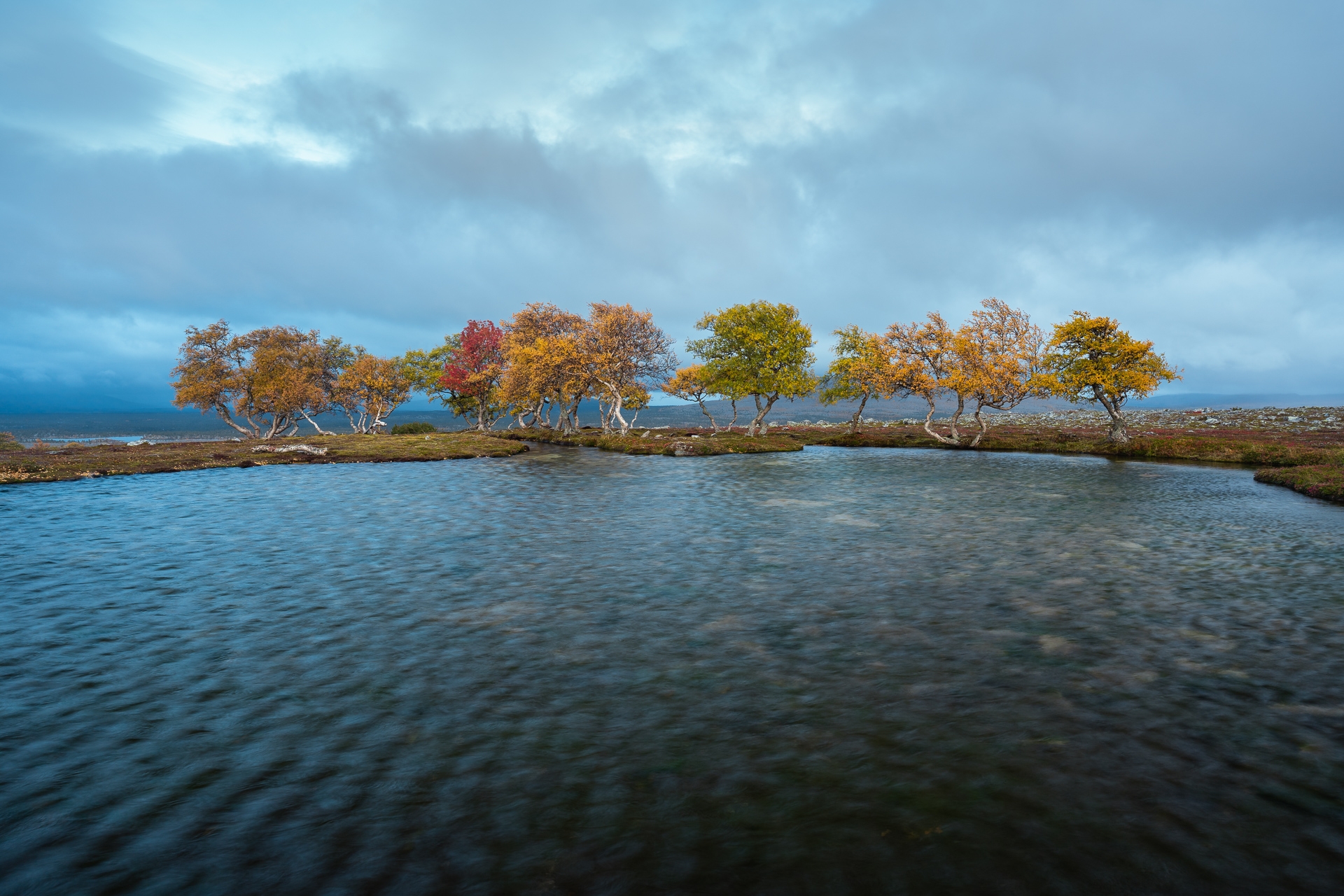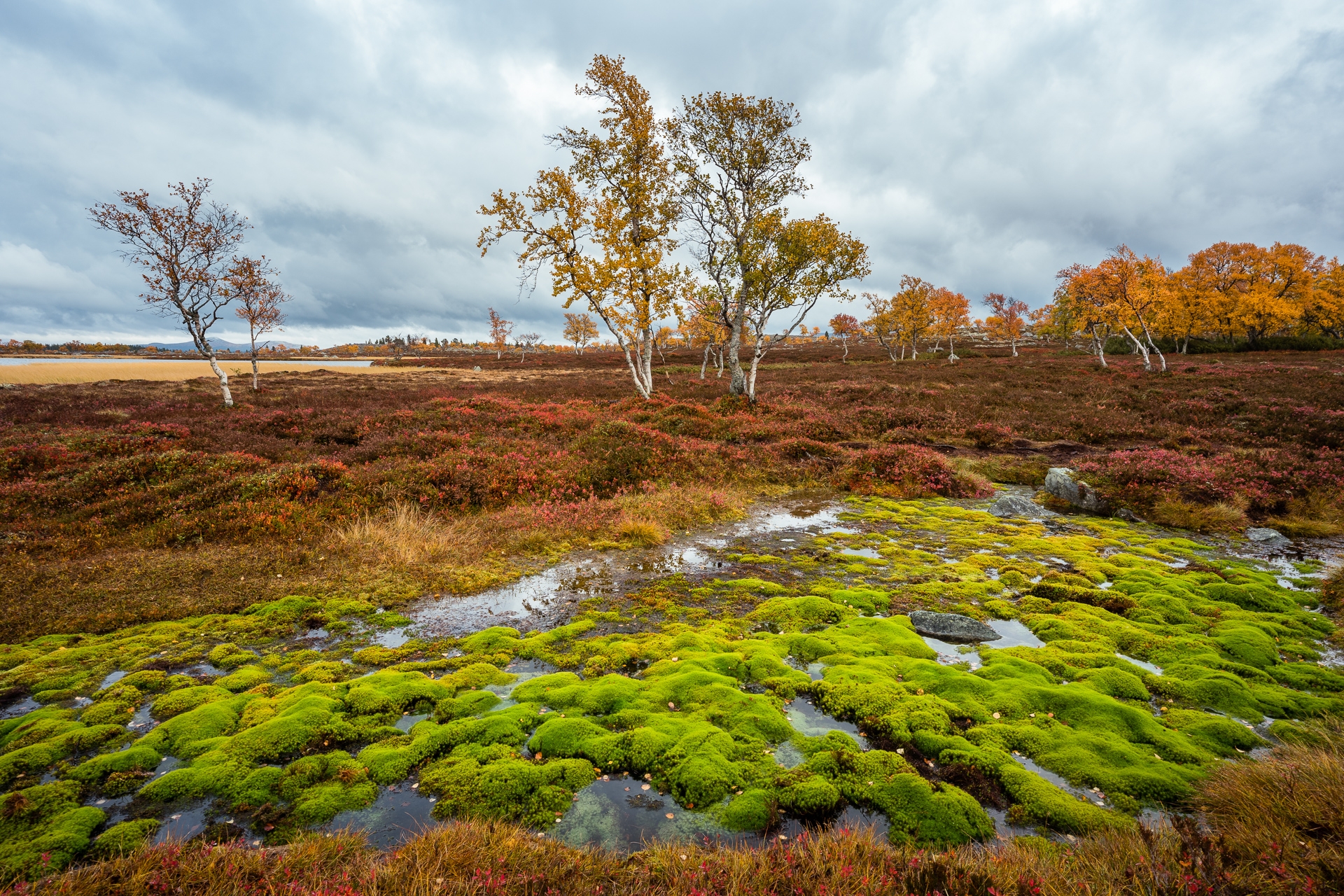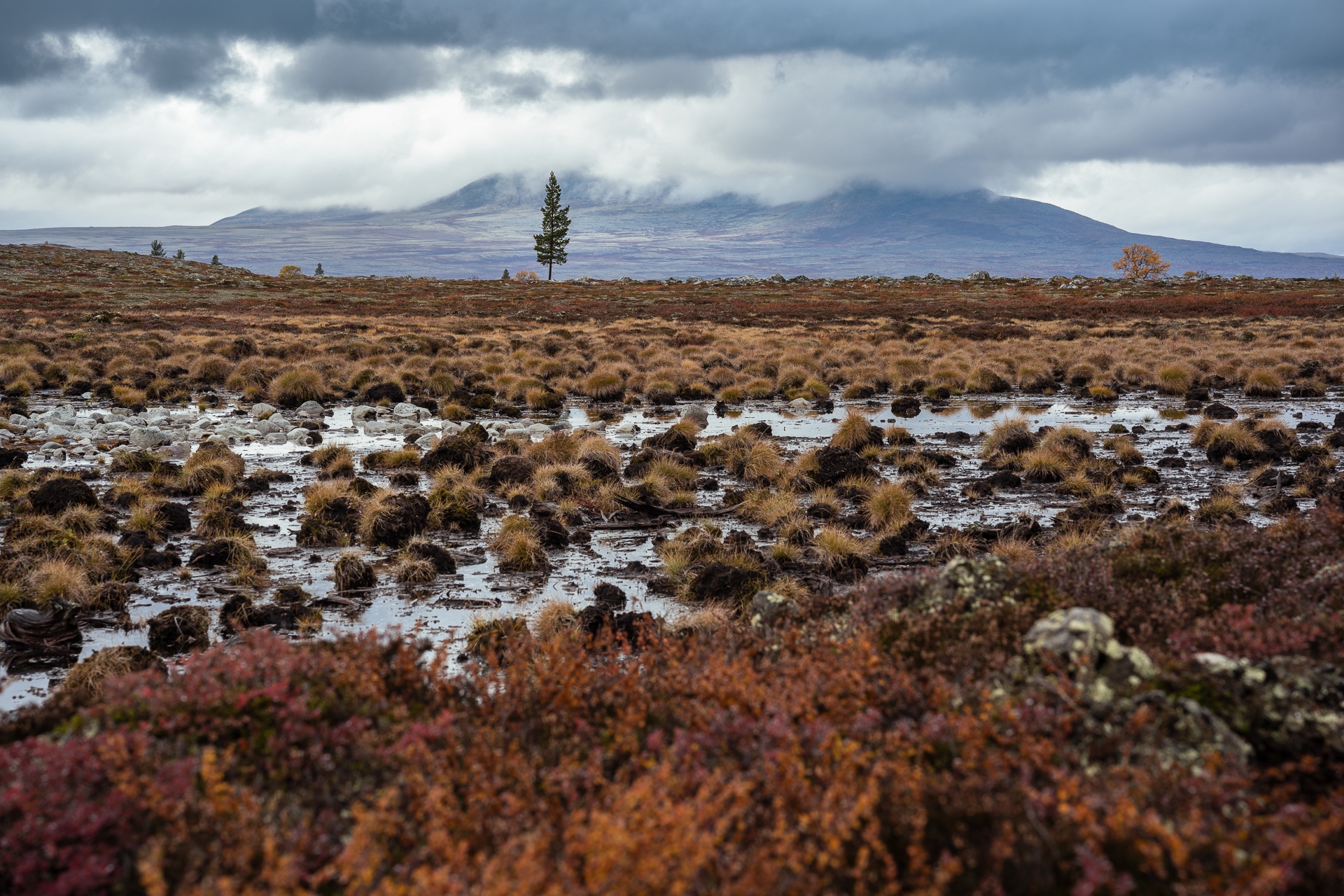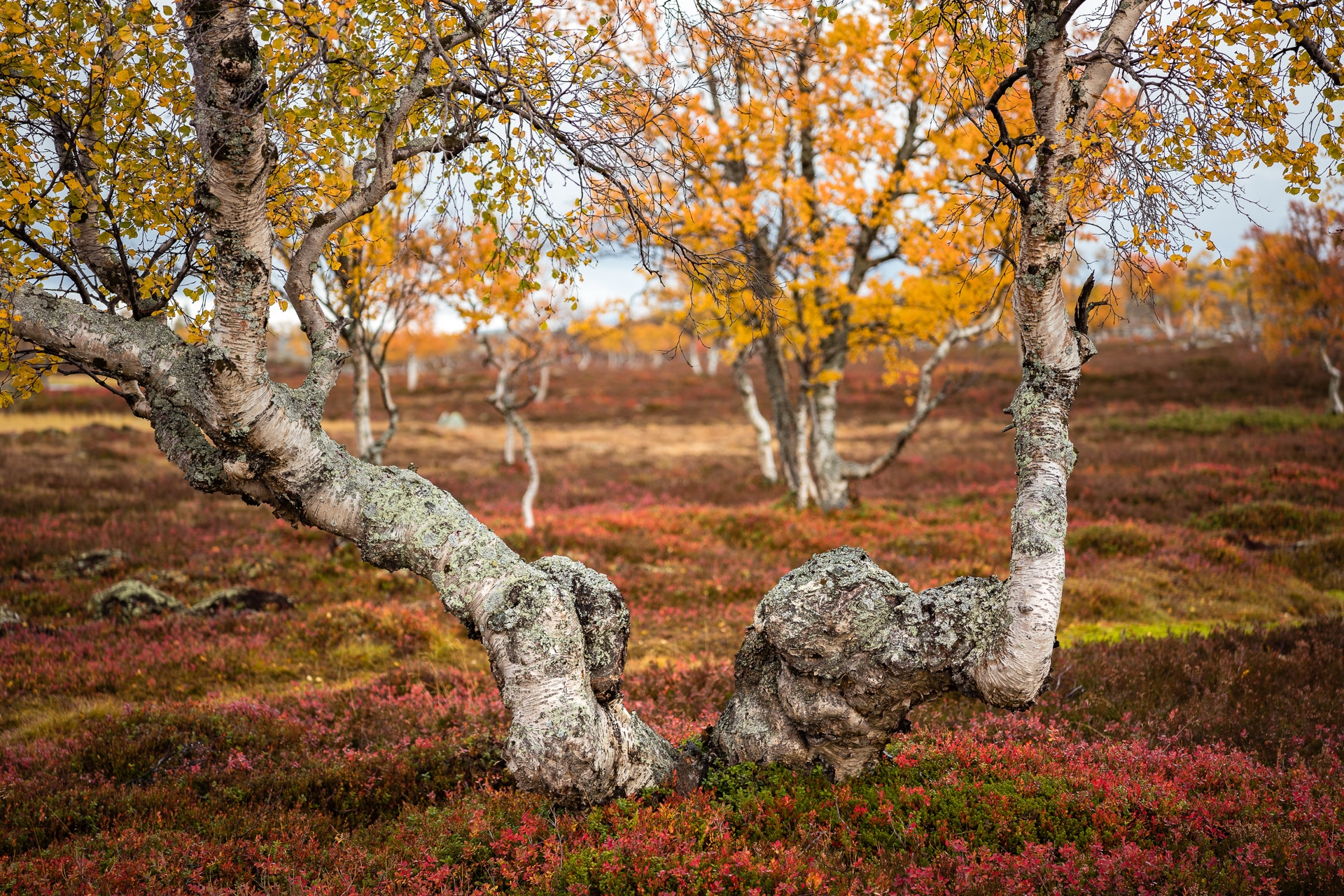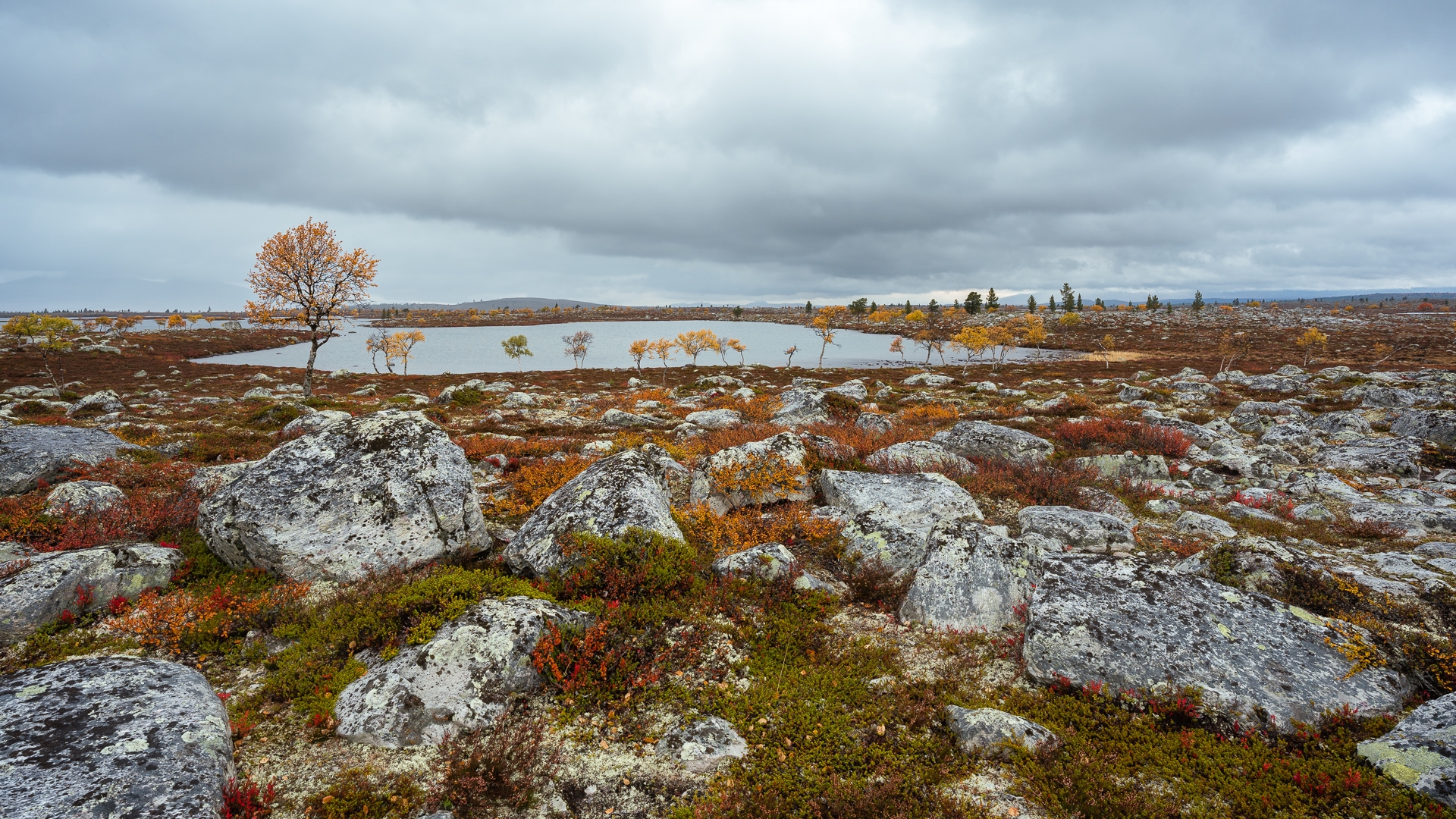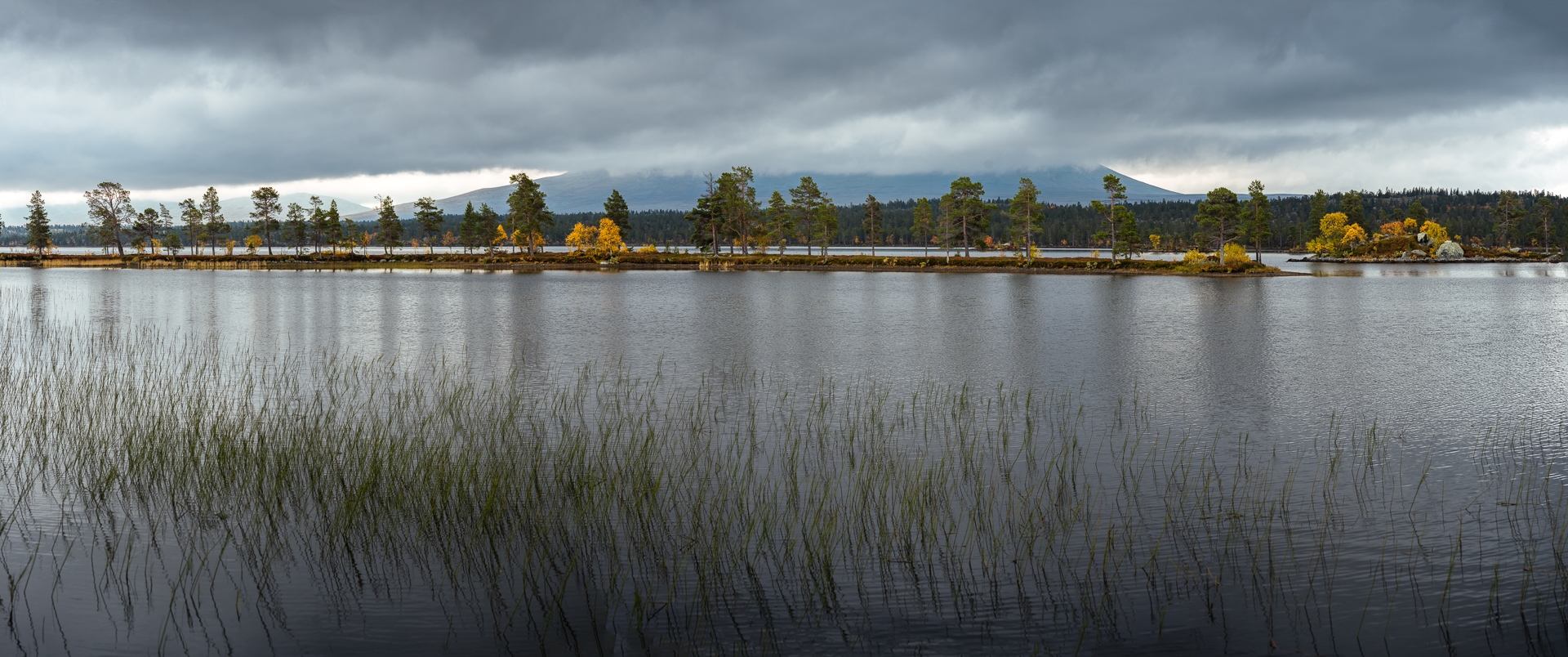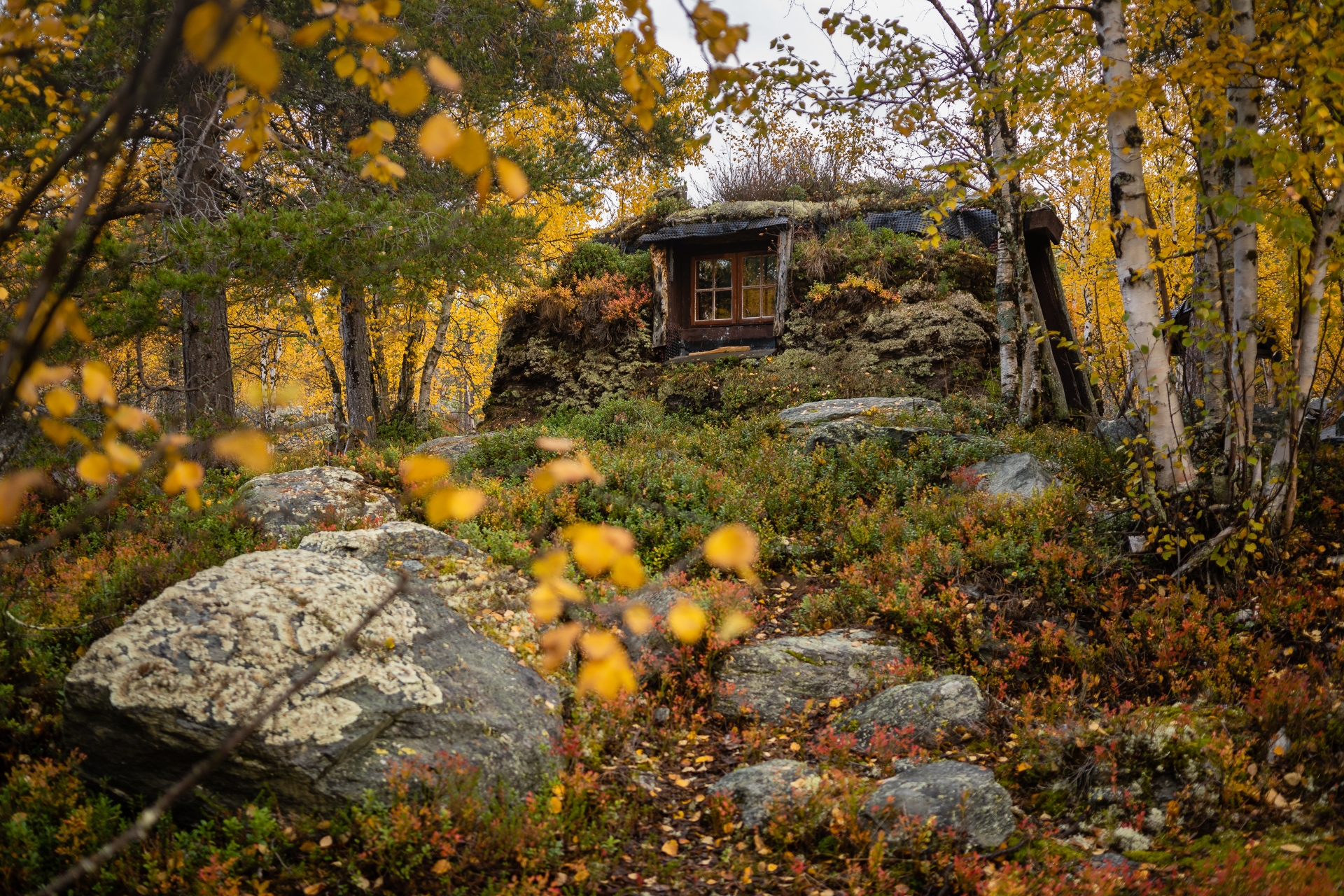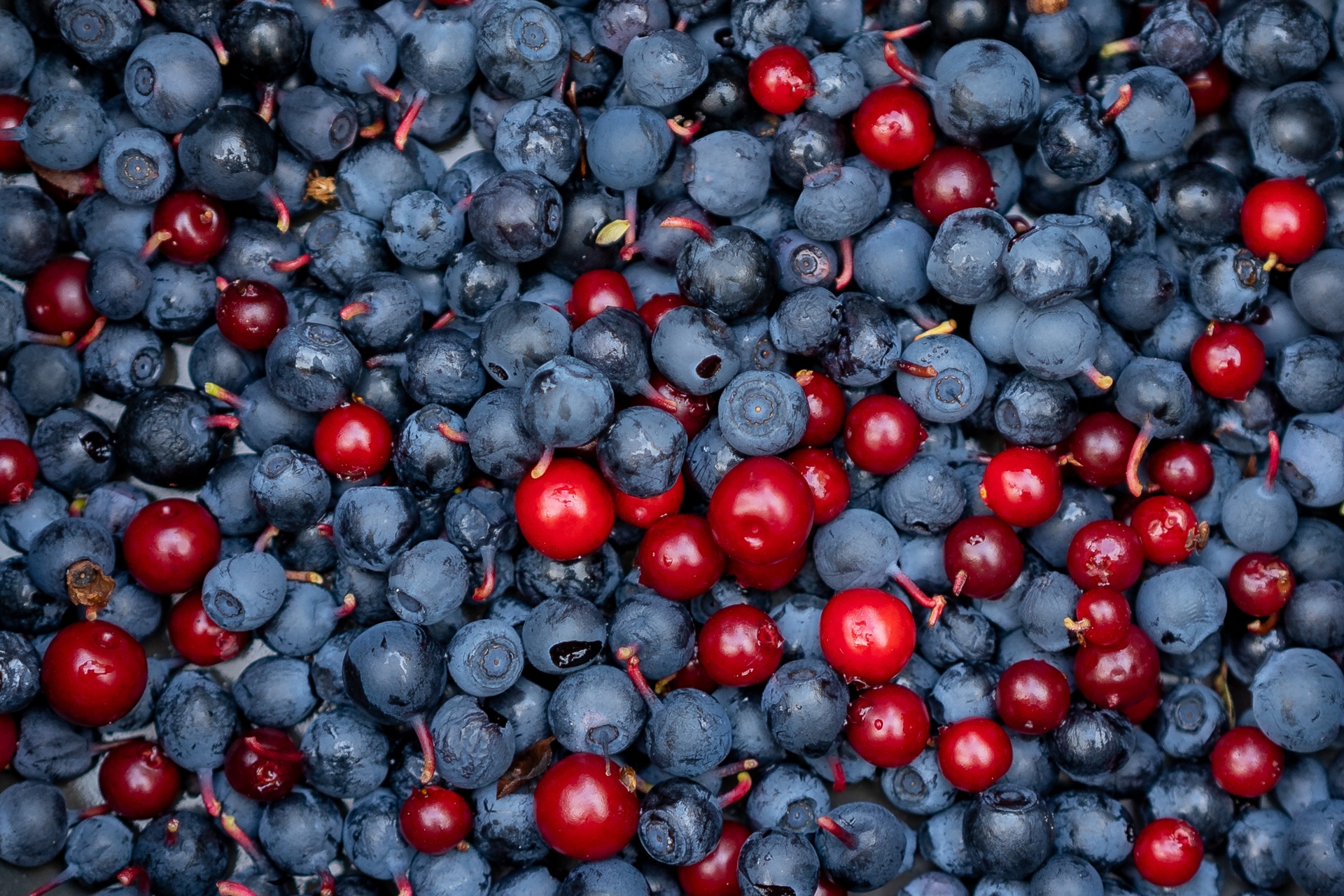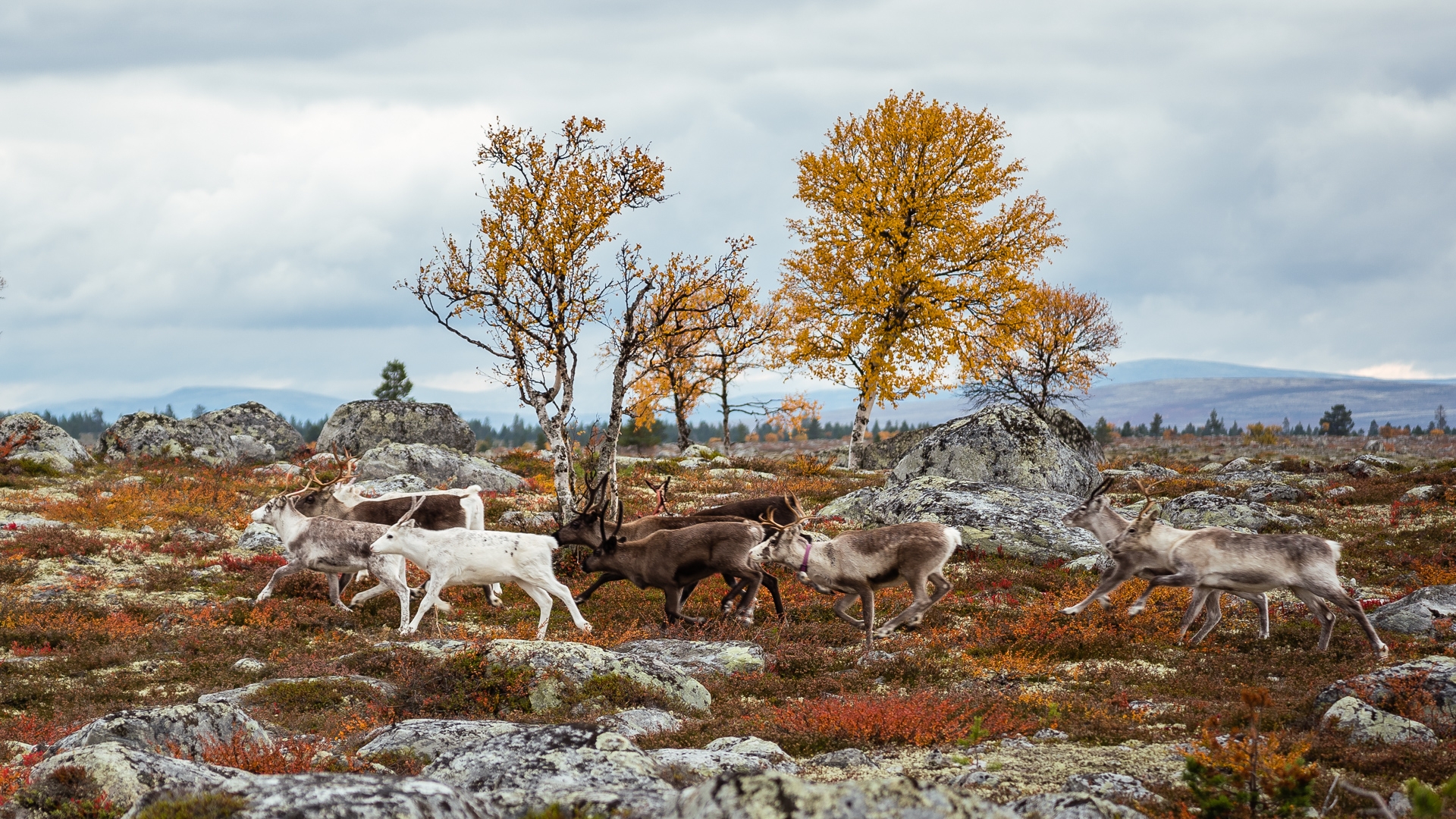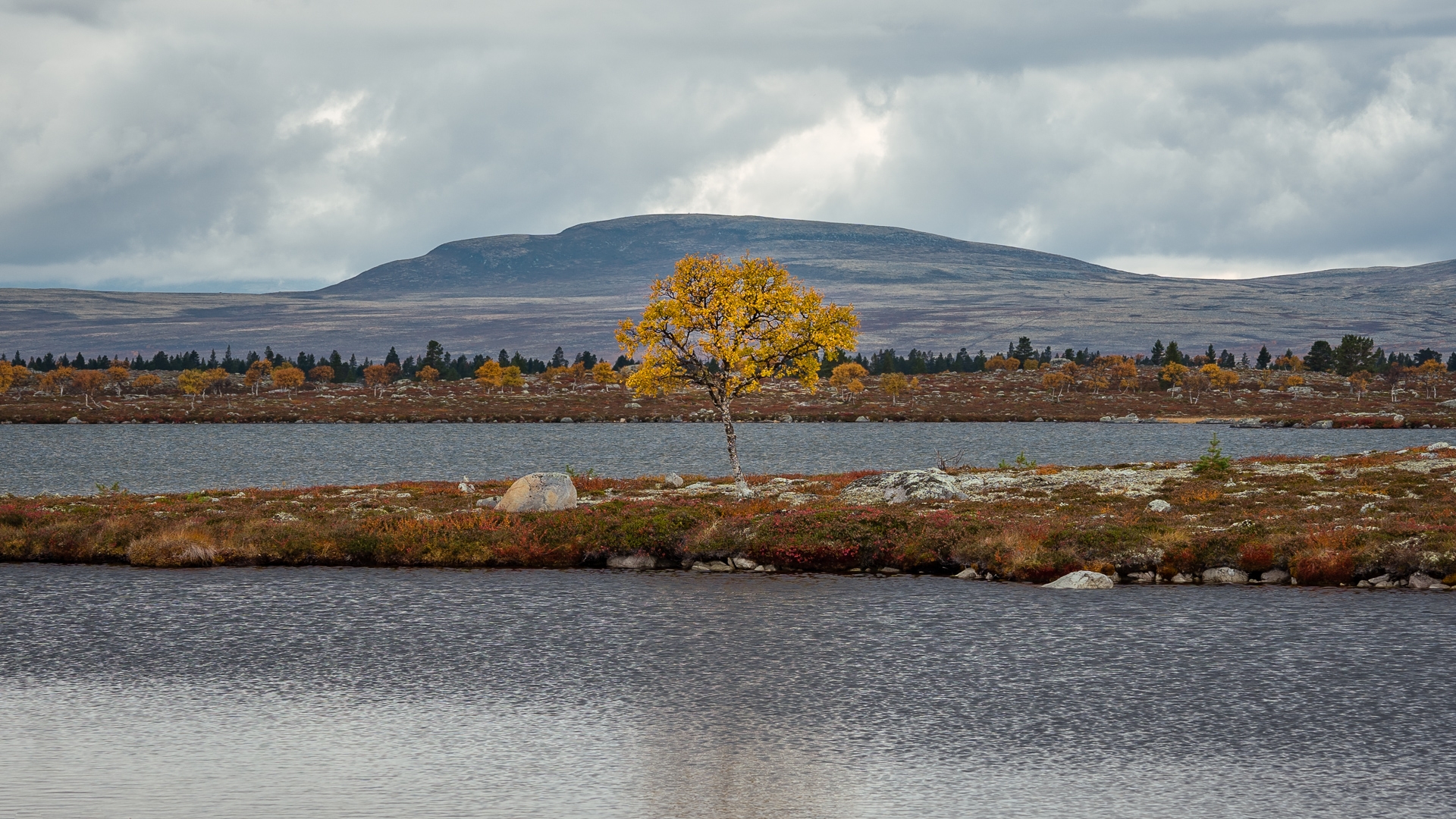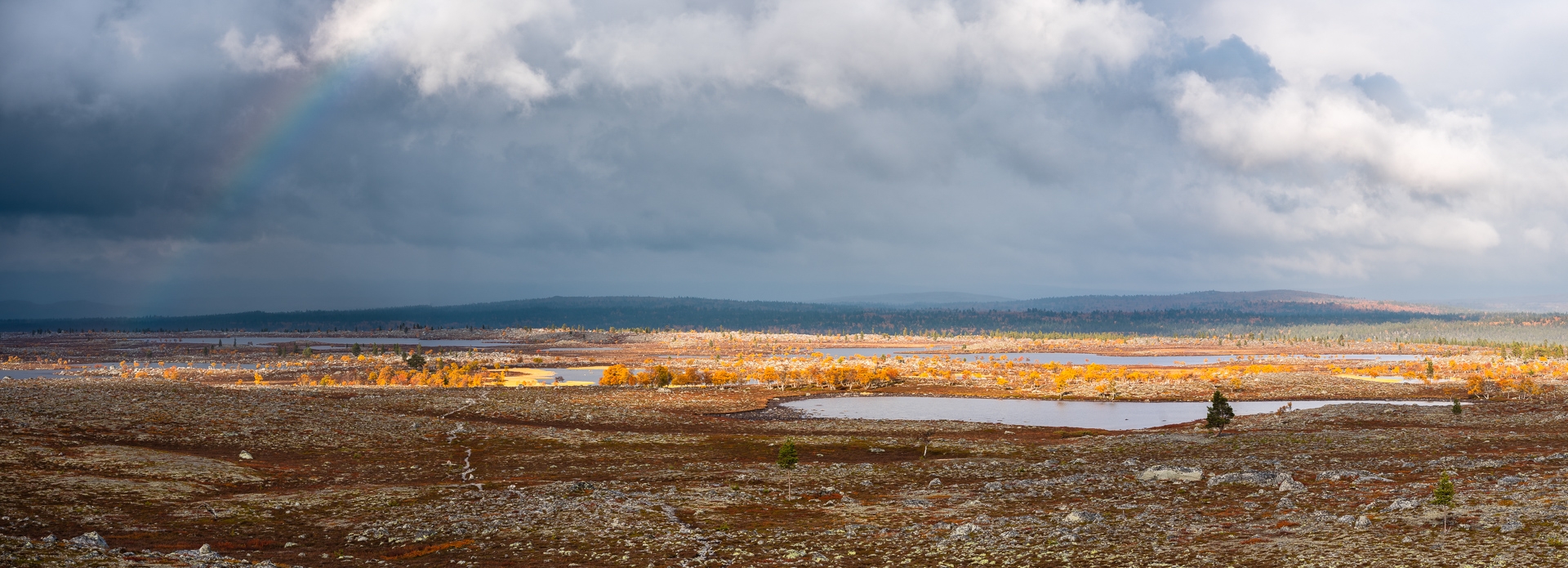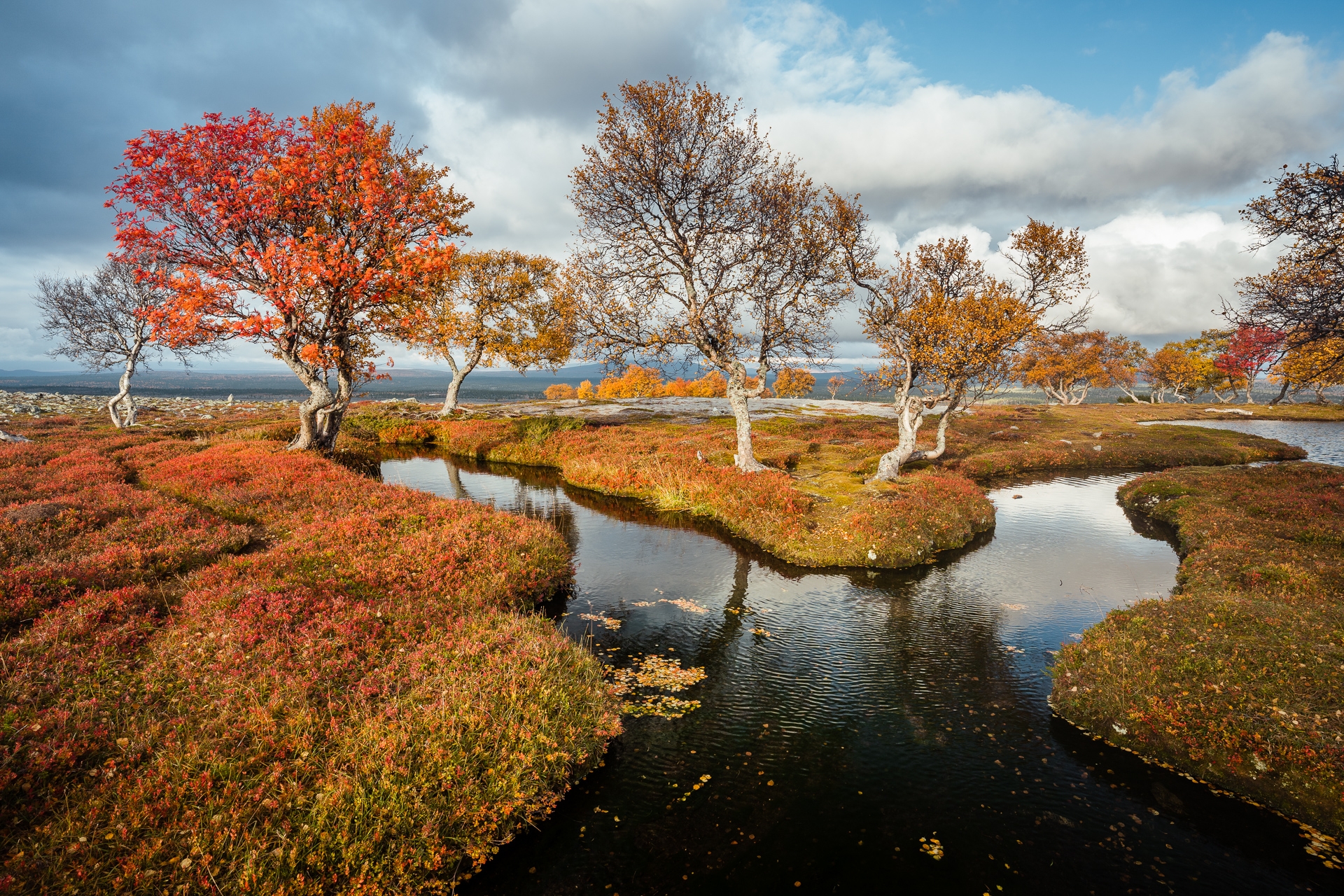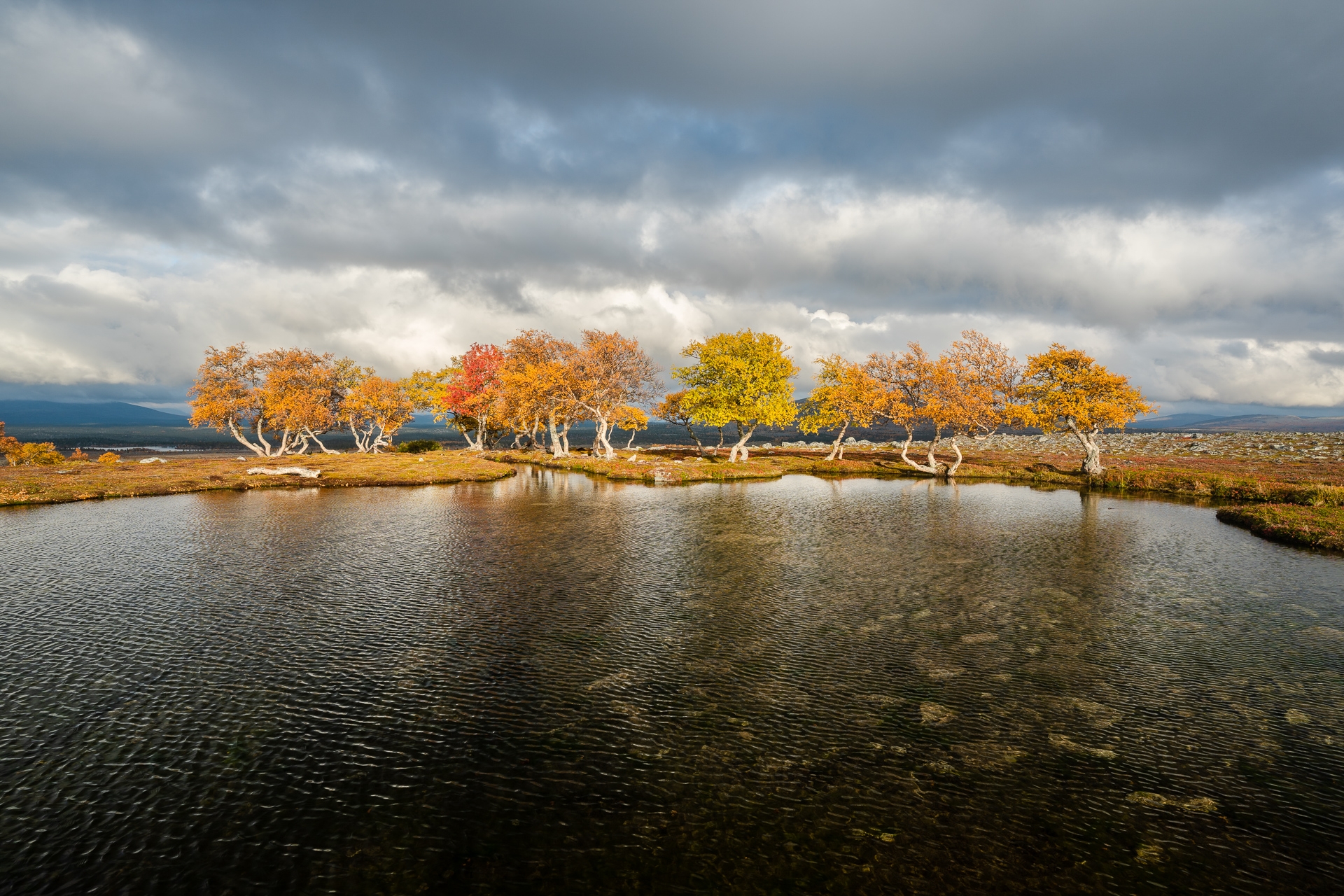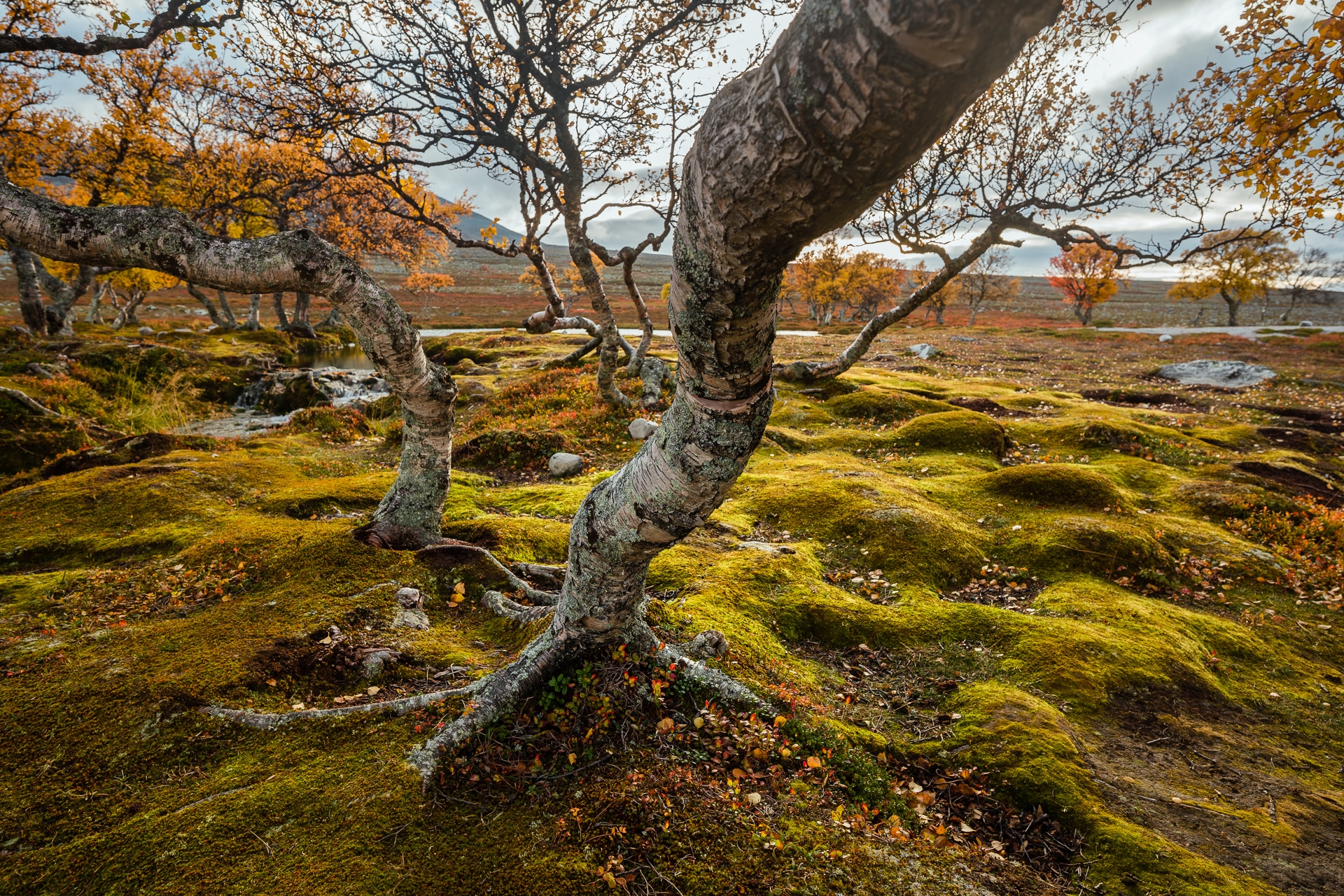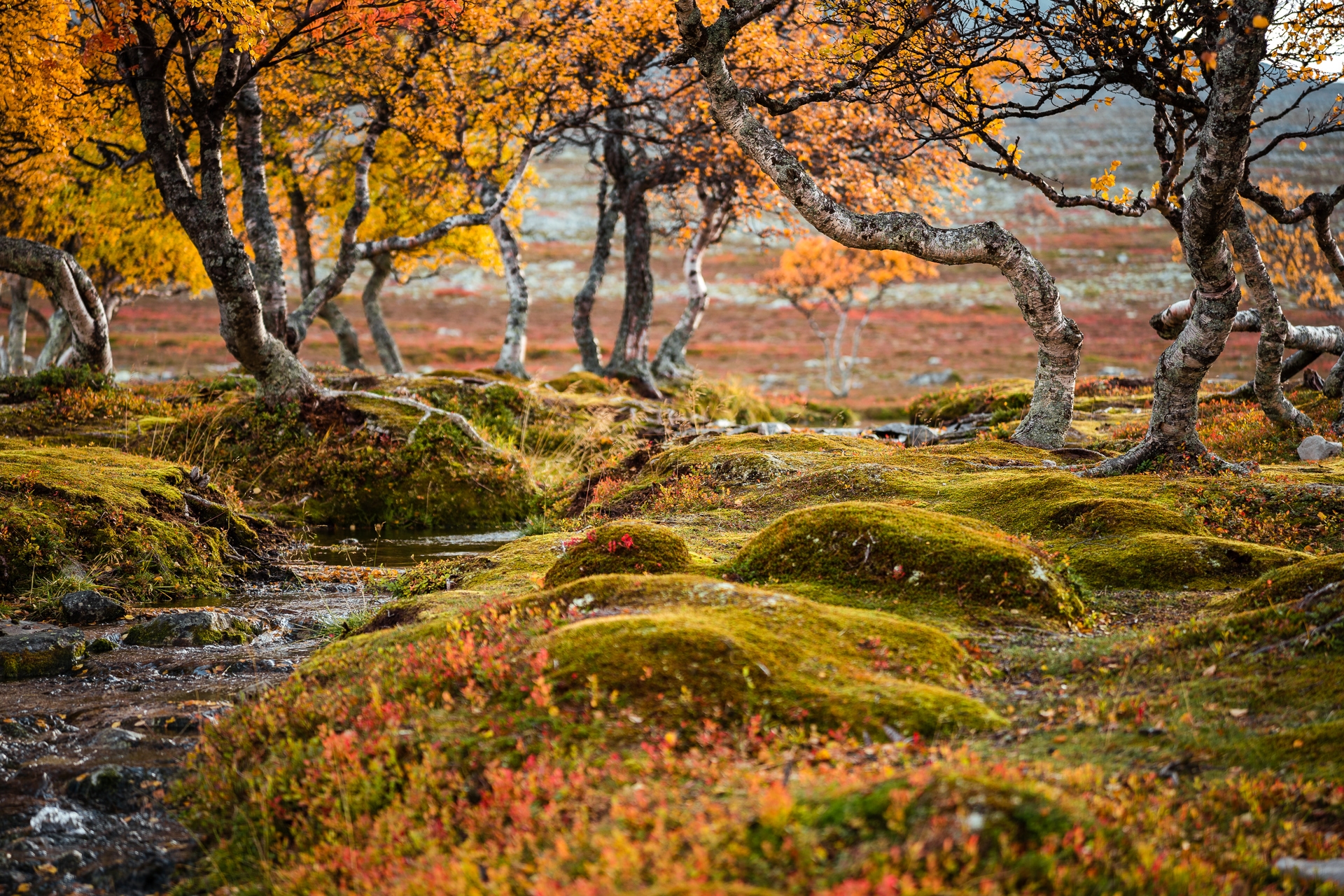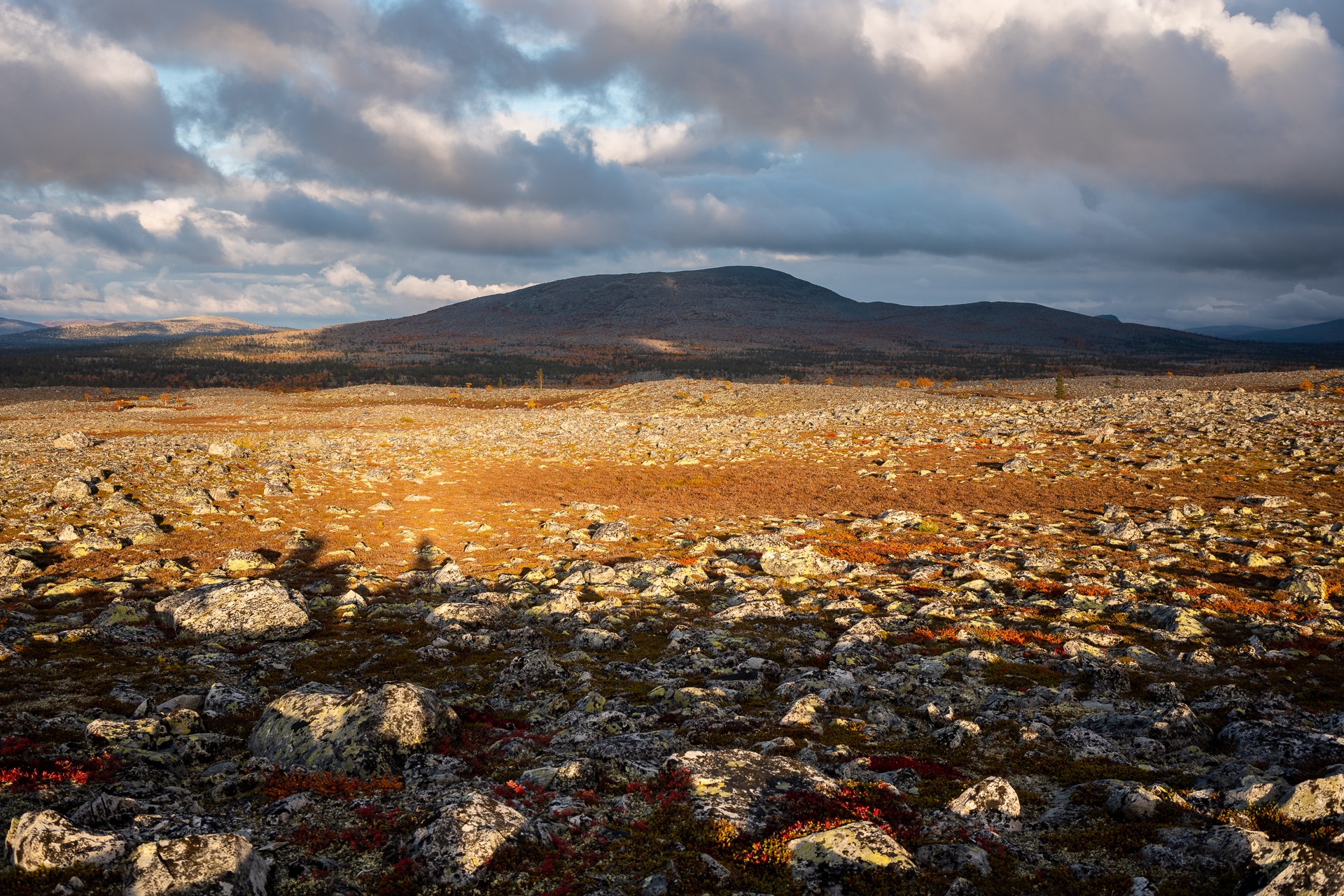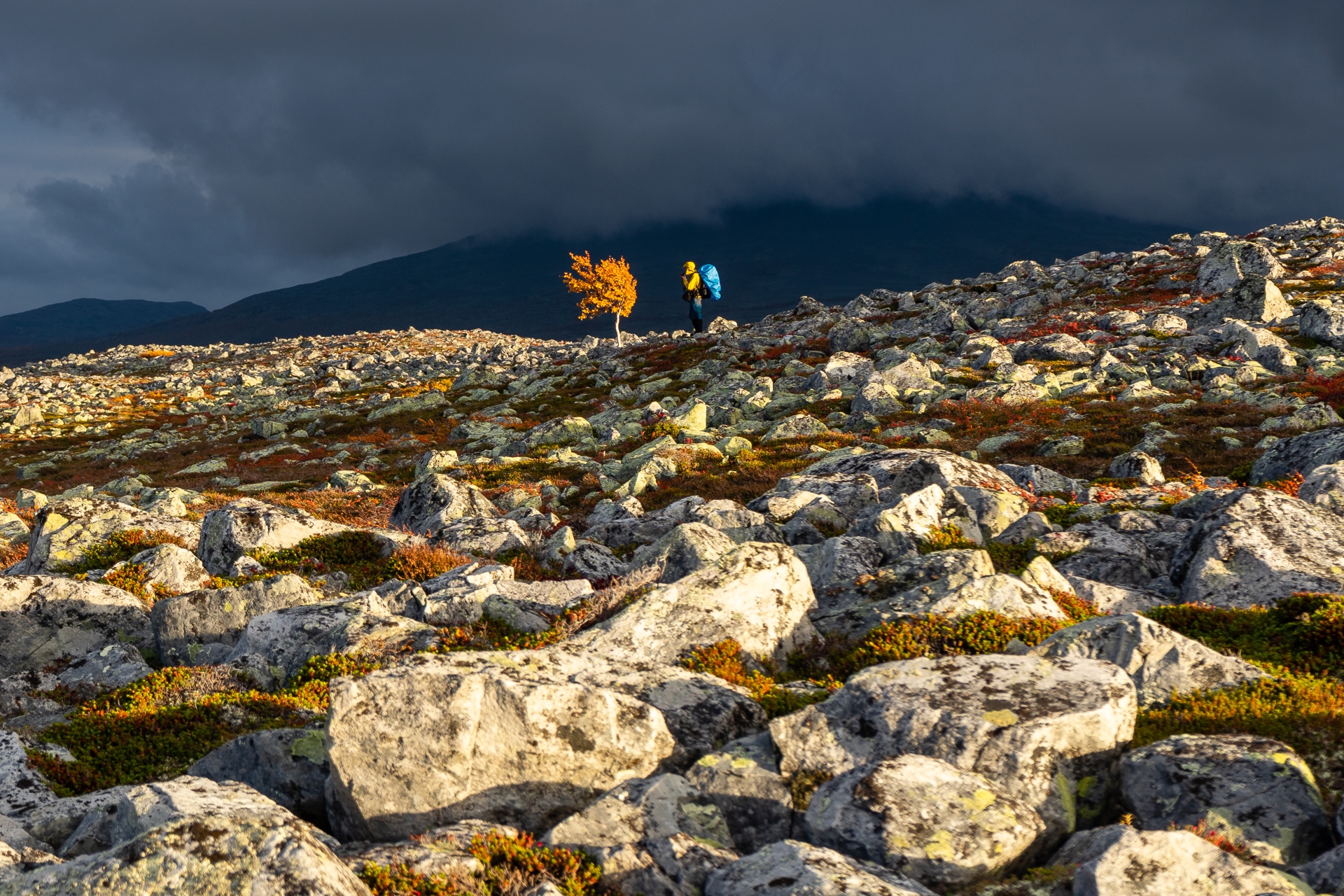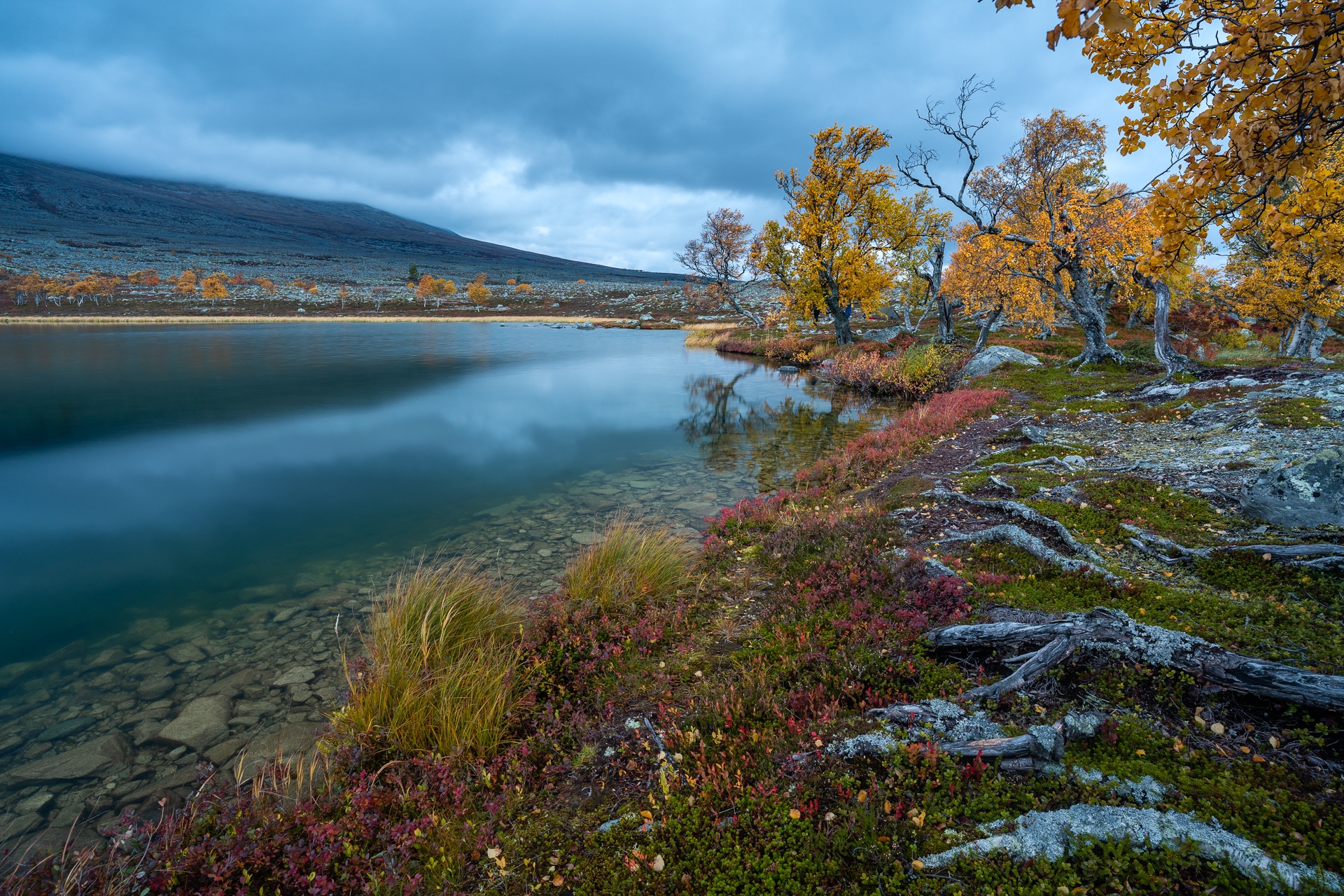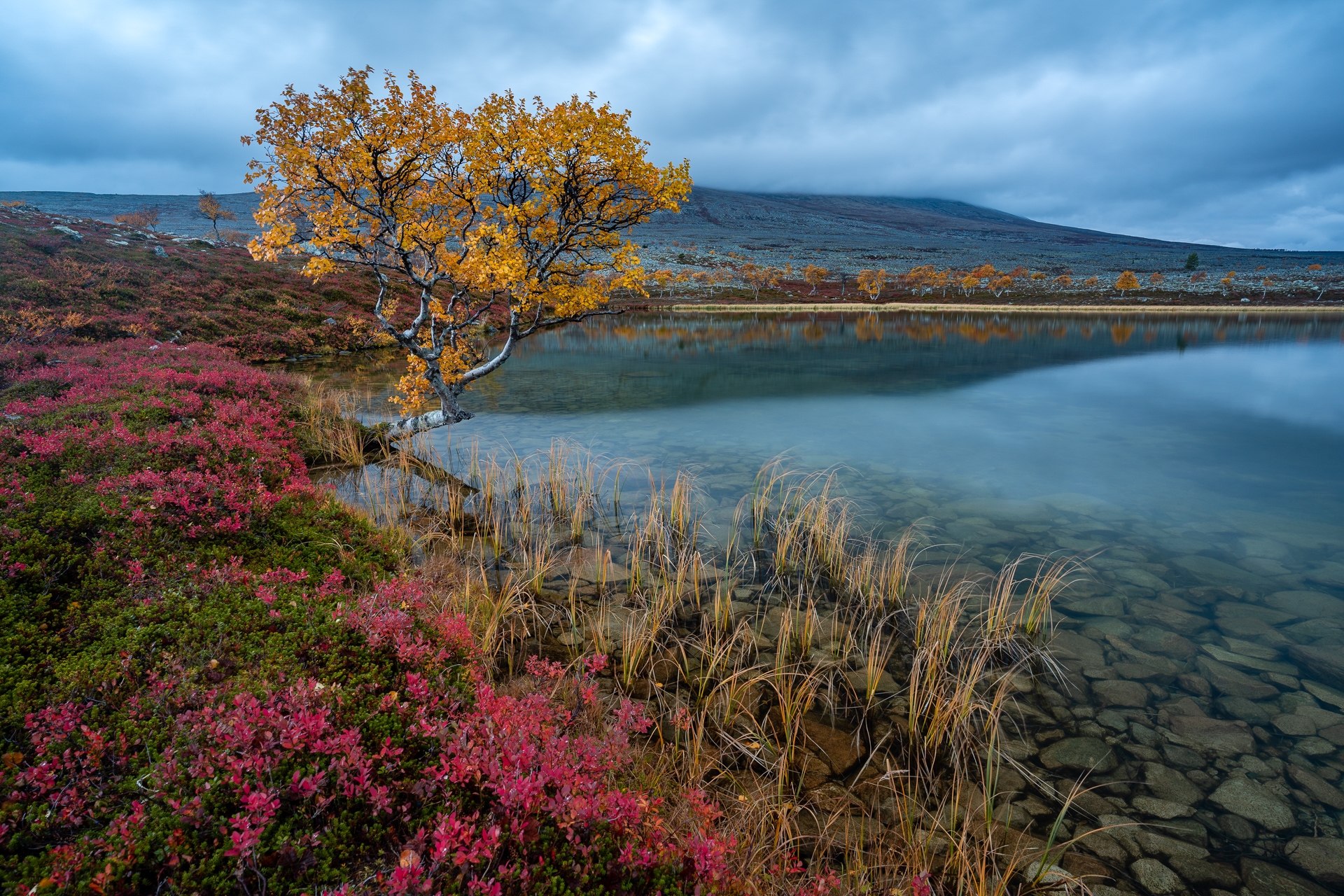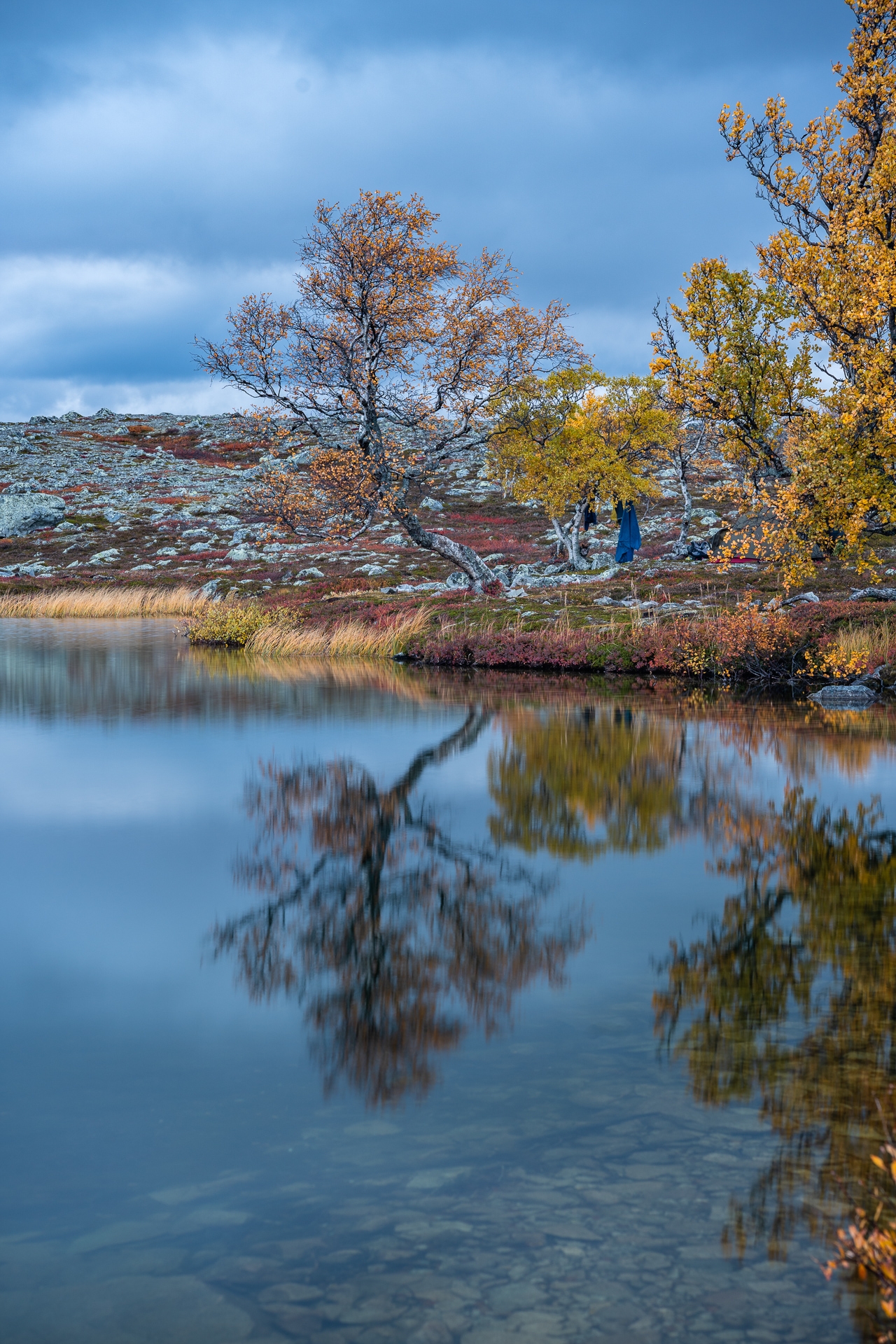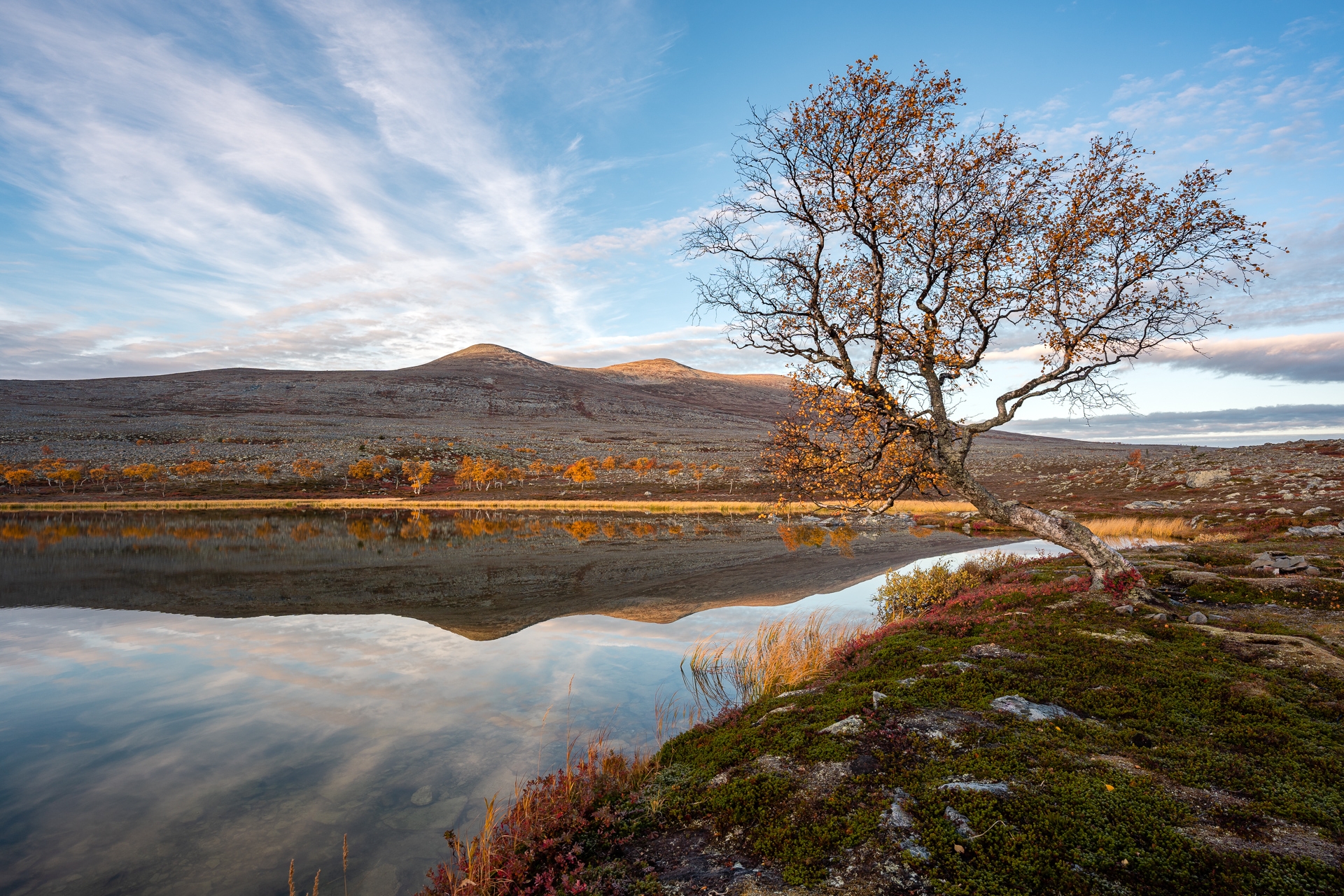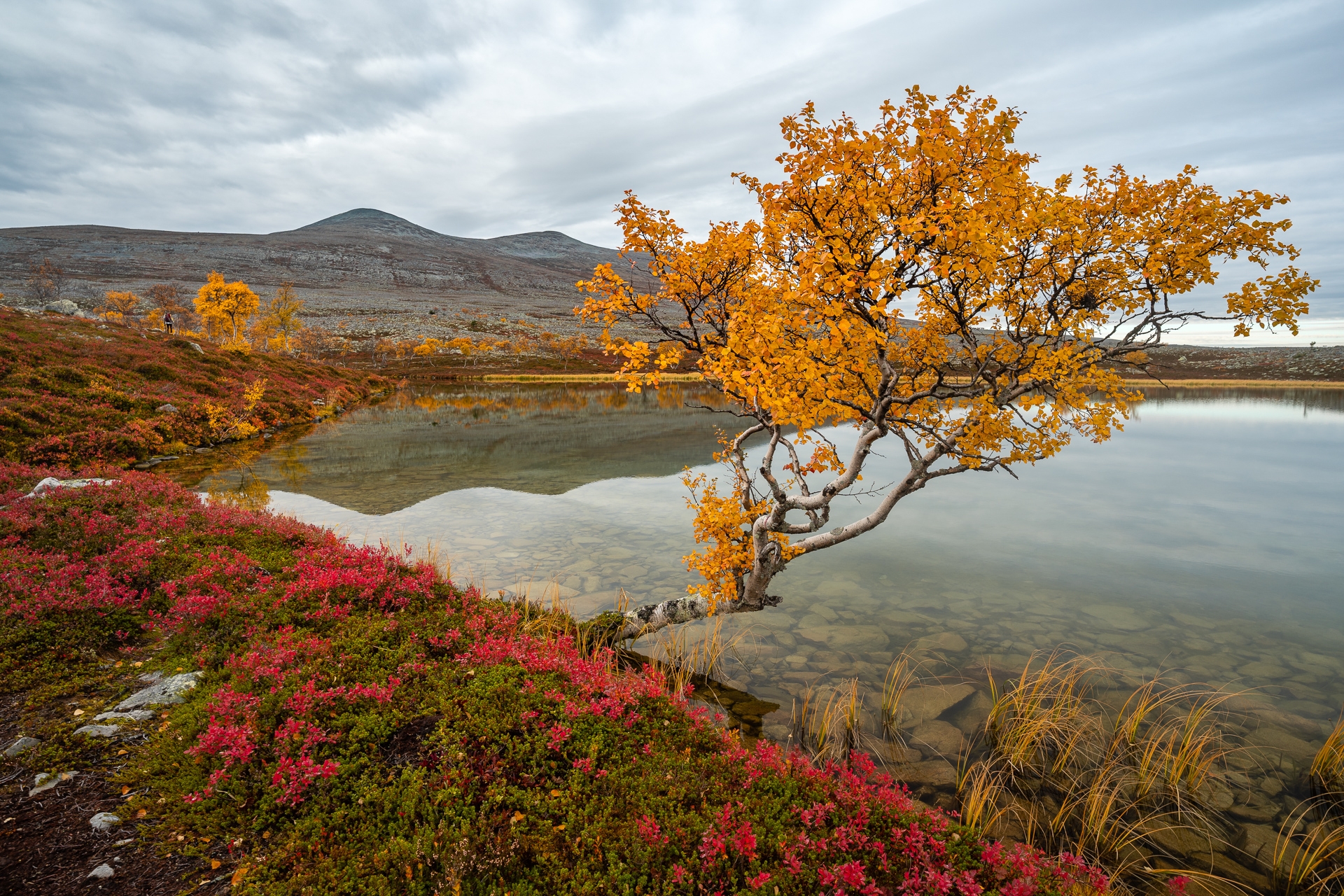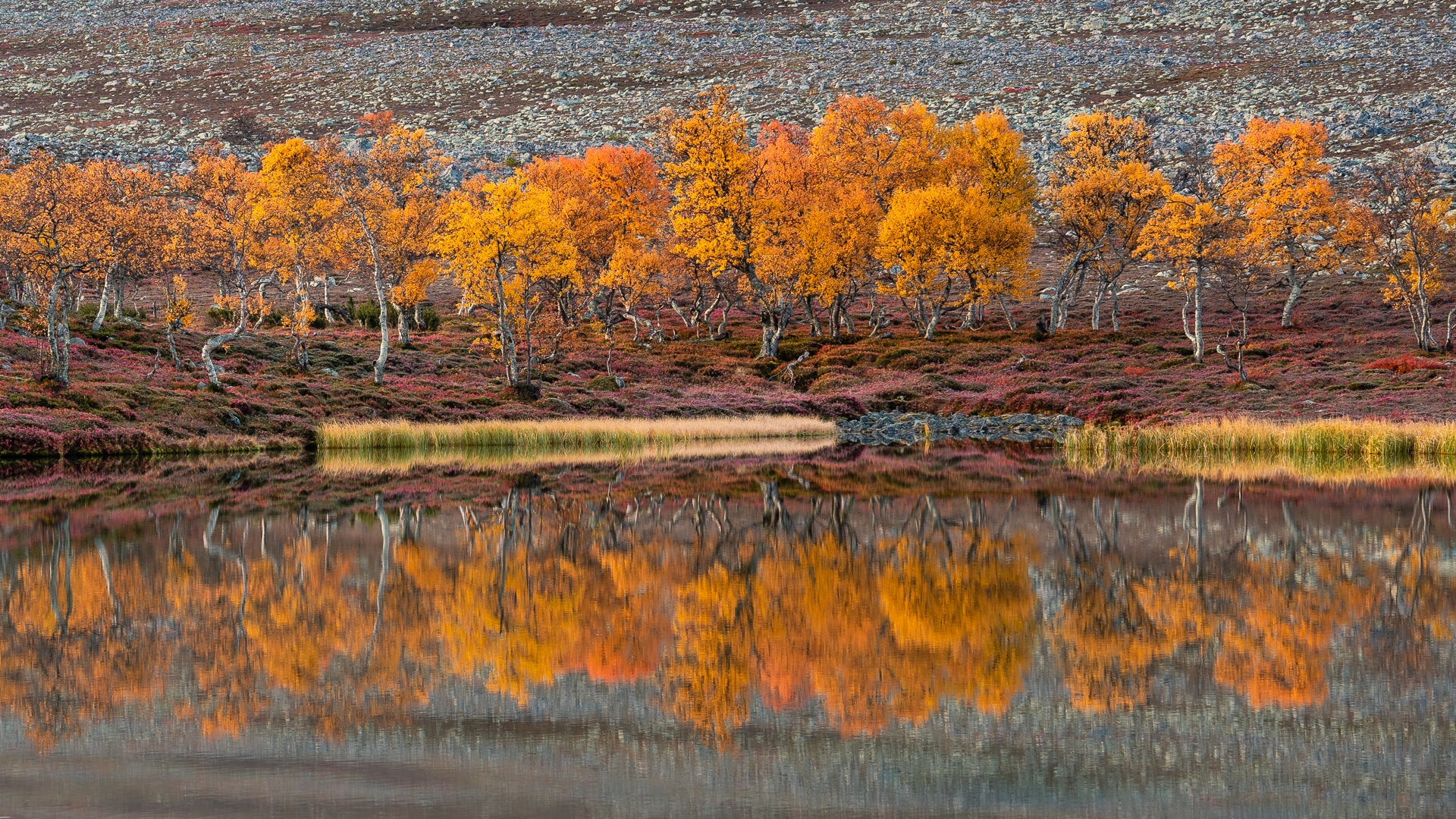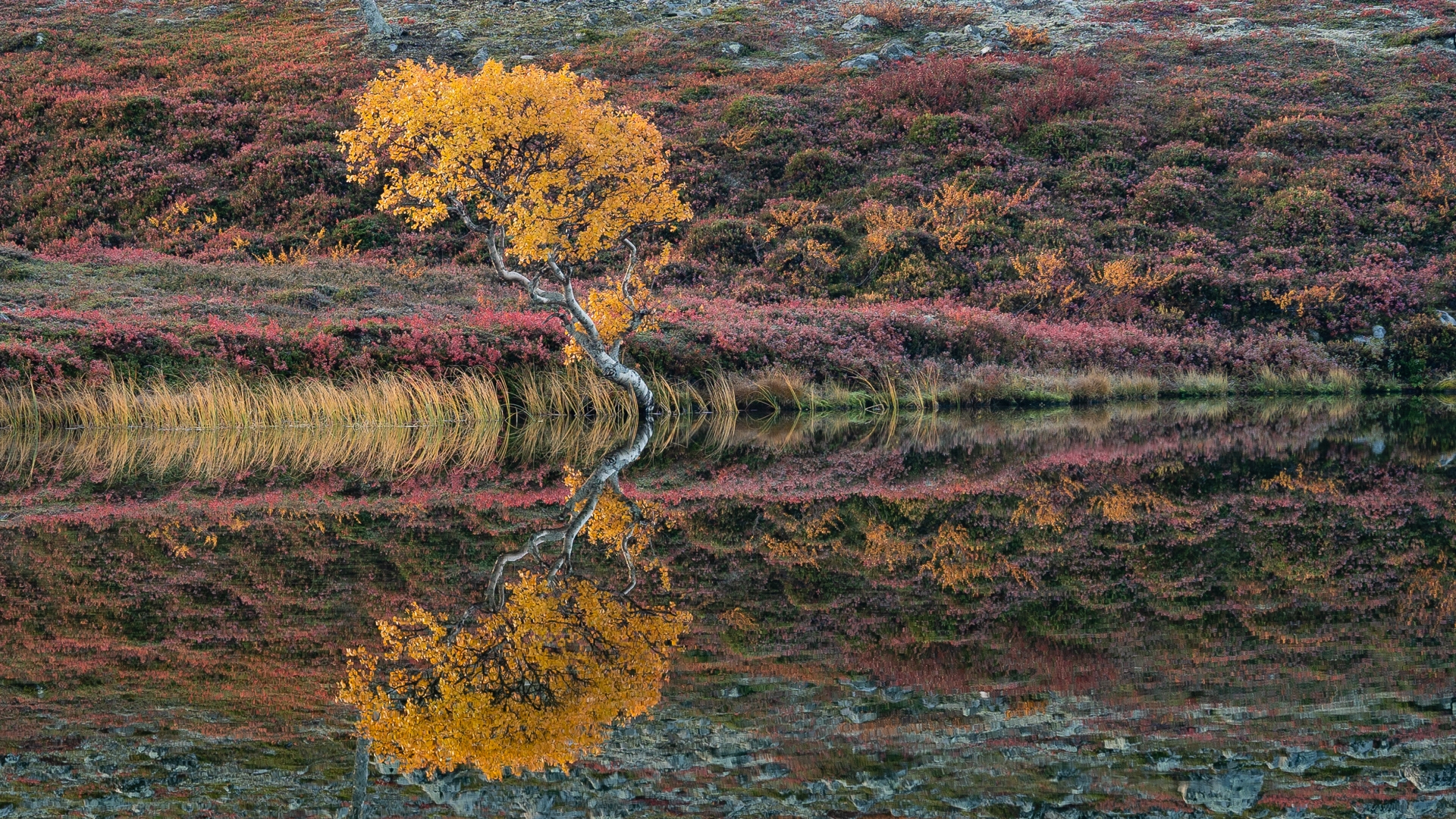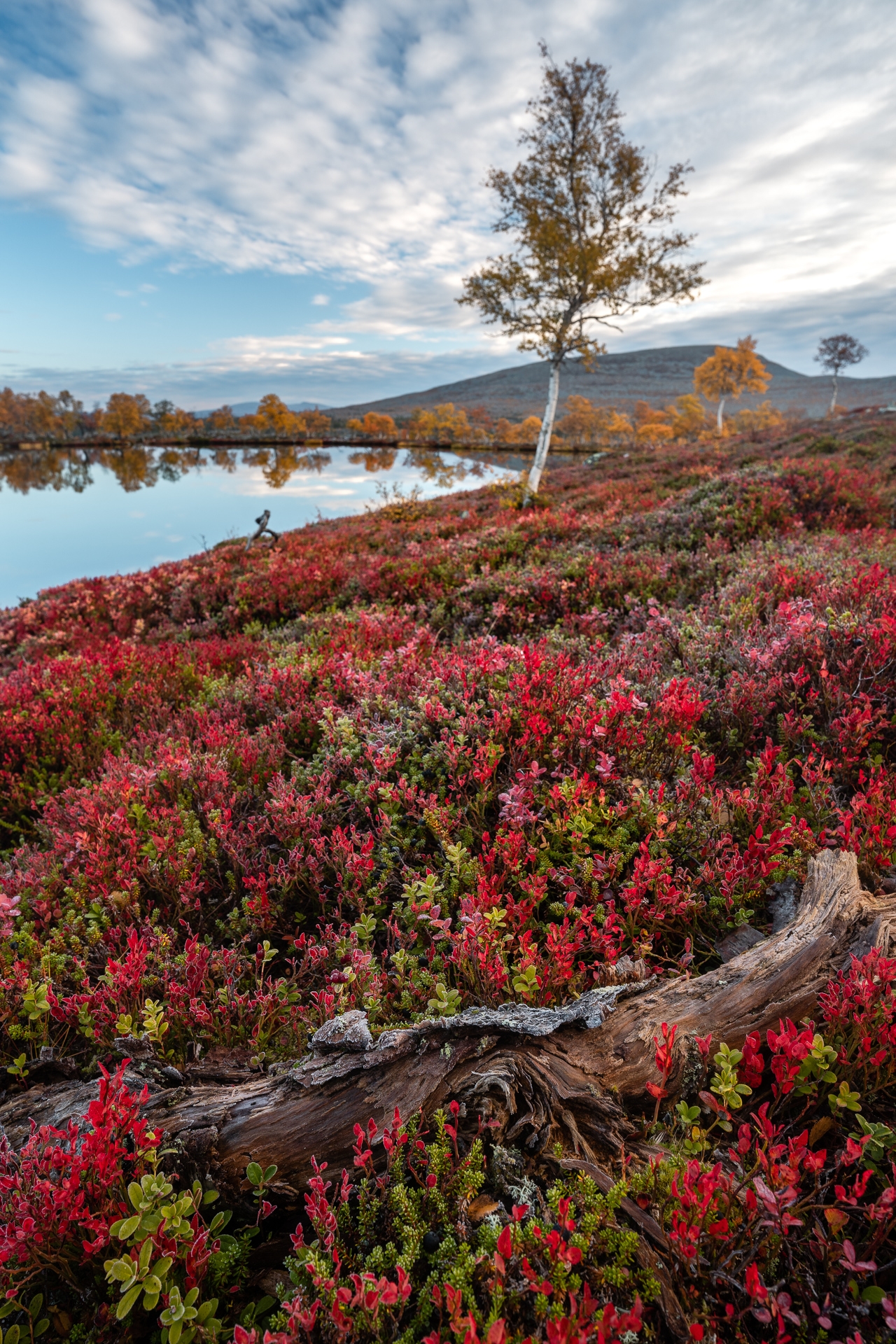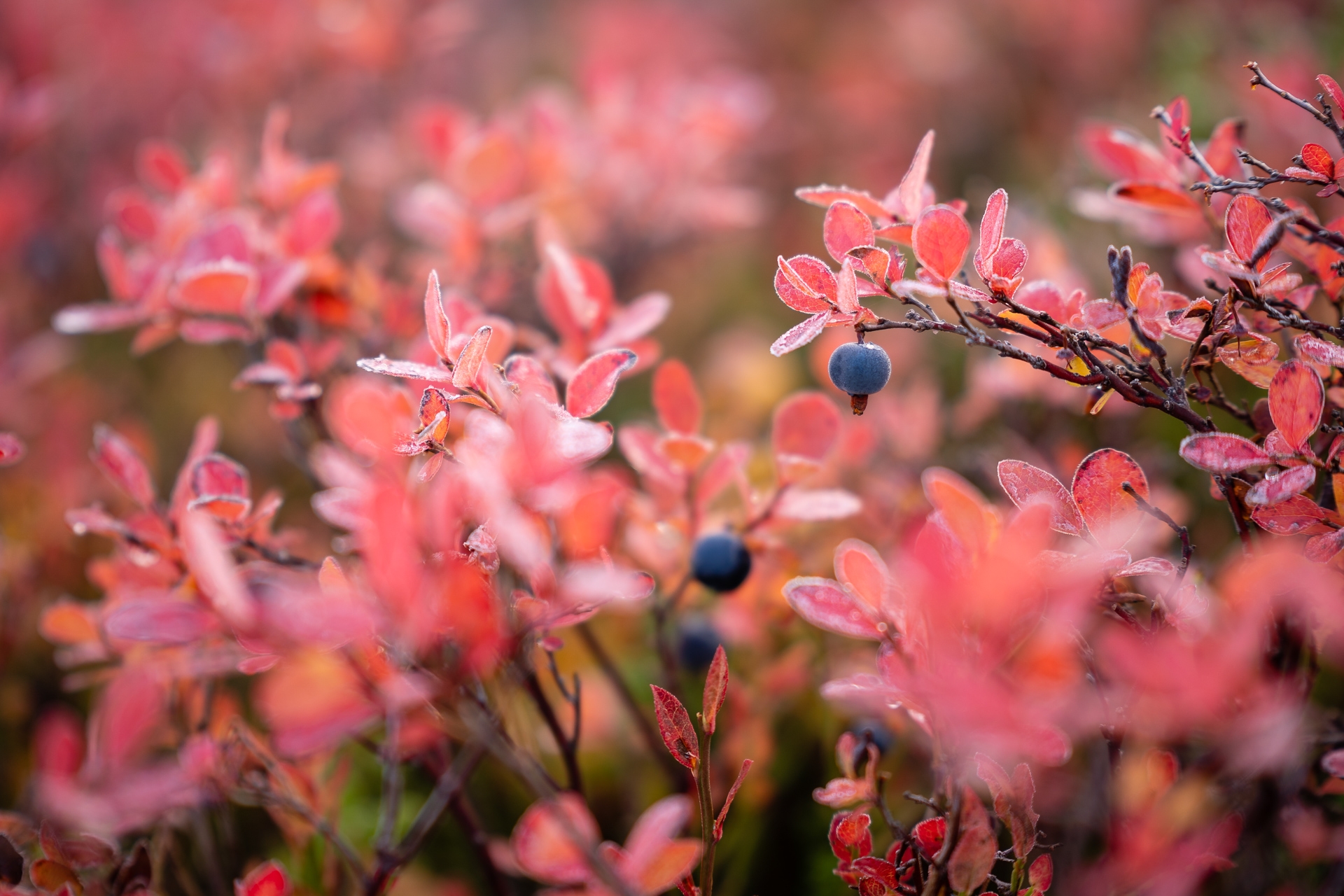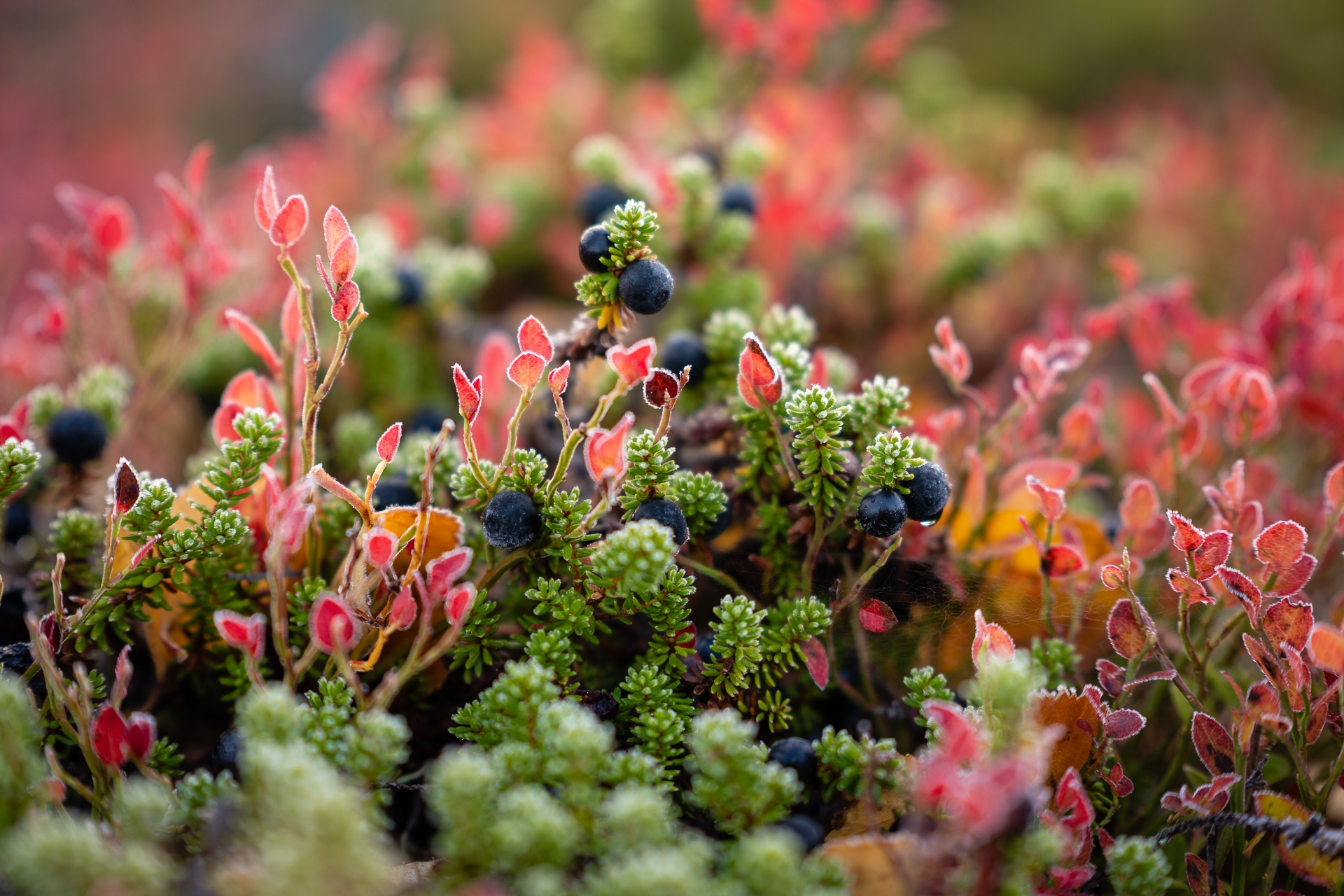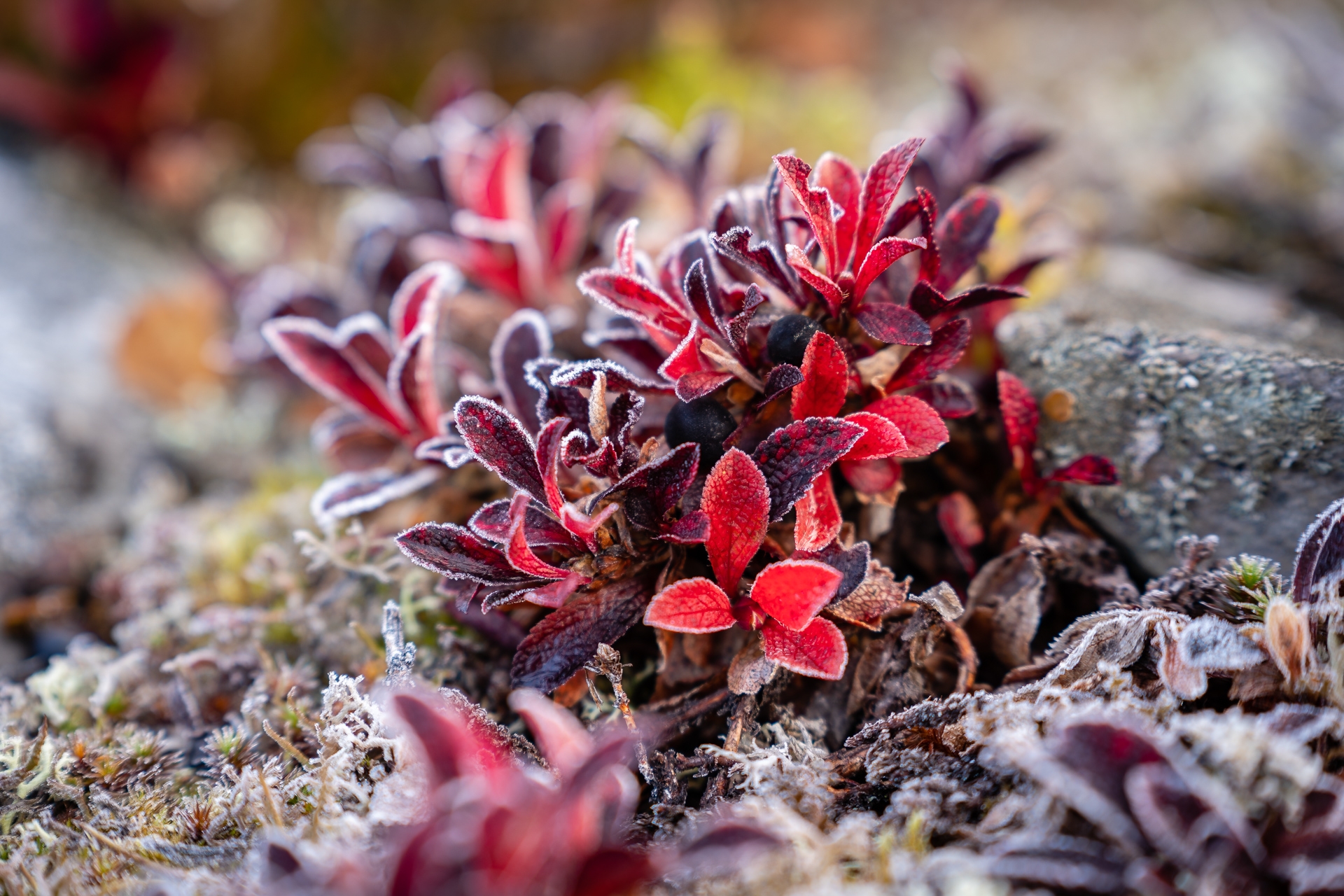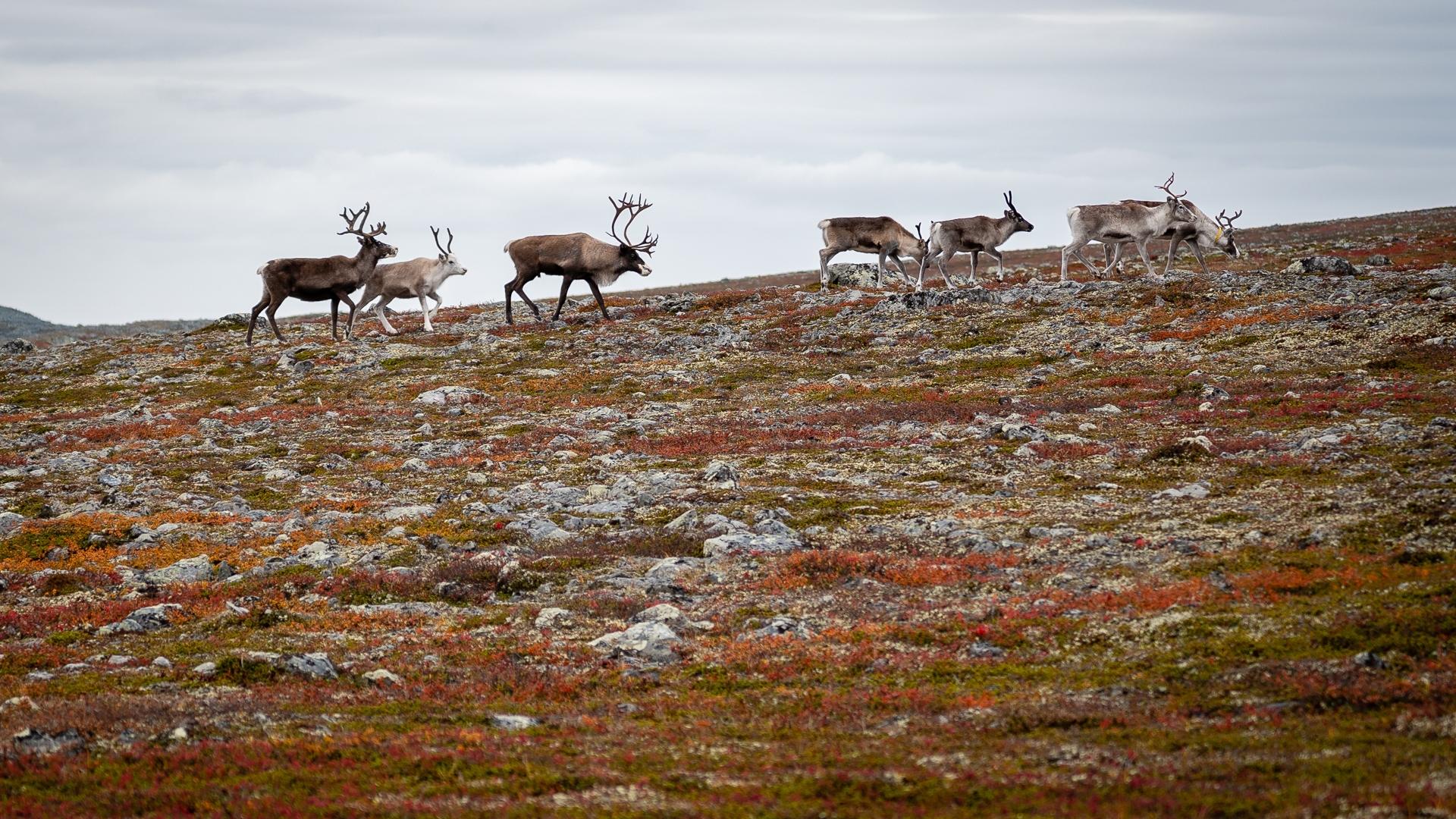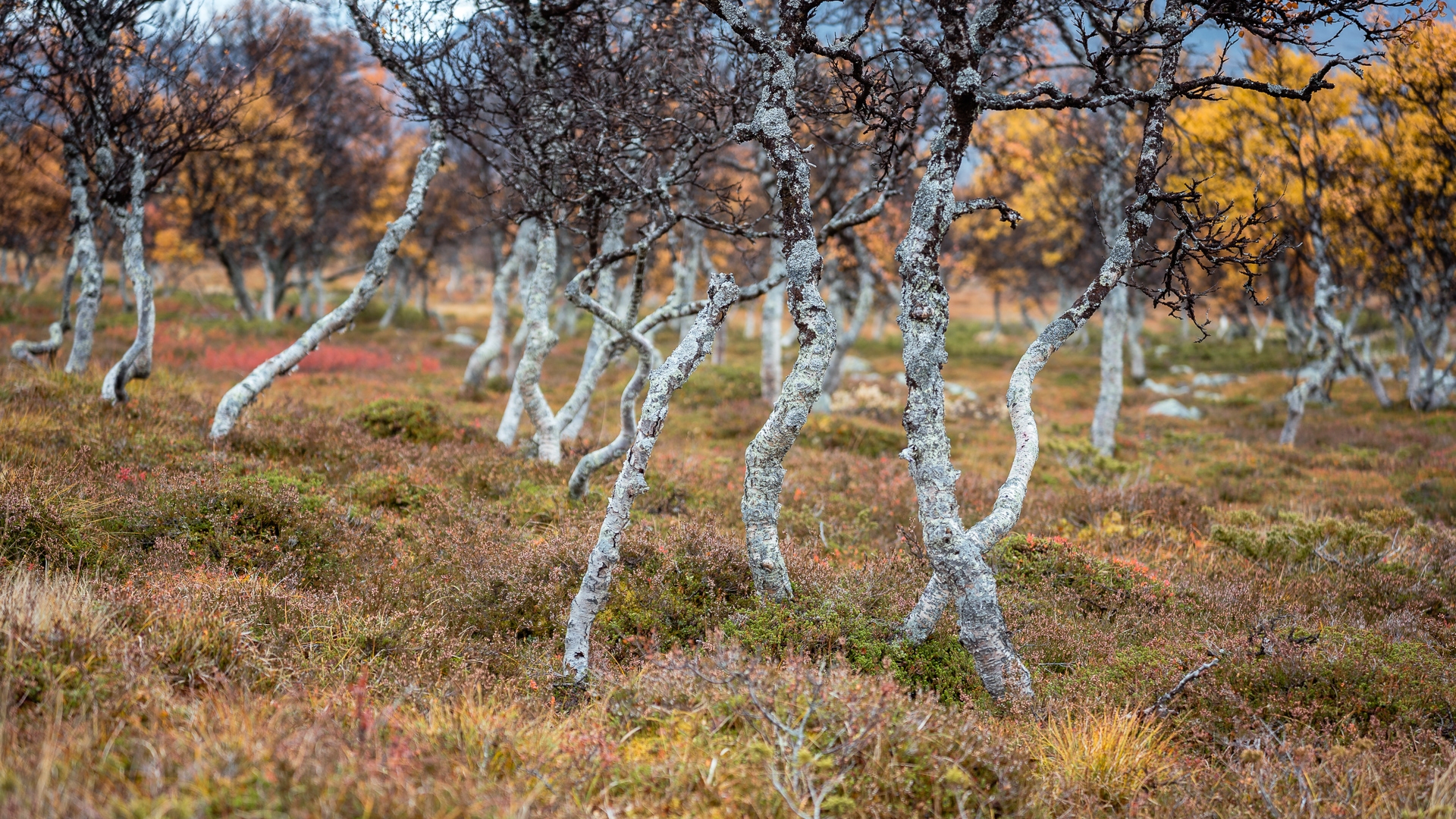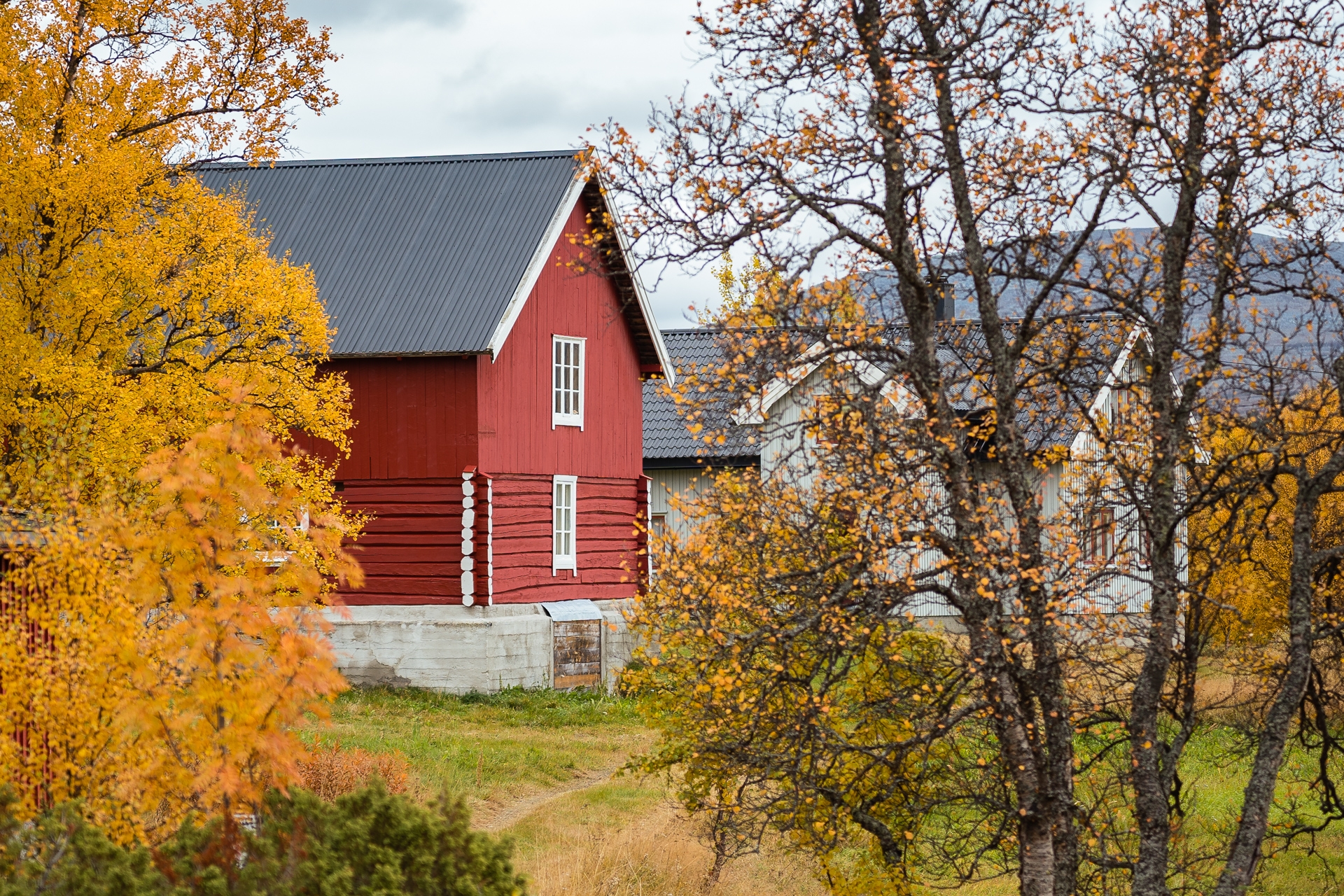Looking at a map of Norway, few people would think of going to Femundsmarka. The national park near the border with Sweden offers neither high mountains, glaciers nor fjords. Perhaps I myself have sometimes doubted that it makes sense to go here. Fortunately, Femundsmarka hides a few aces up its sleeve. First and foremost is the seemingly empty landscape itself, transitioning from taiga to tundra with its rounded slopes, the endless number of lakes and probably the most important thing - the colourful autumn.
The colourful autumn in Norway is said to last 10 days. That is, from the moment the green leaves begin to turn colour until they turn brown and fall. In Femundsmarka, this period should occur around the penultimate week of September. However, we can only start our journey in the last week (for the same reason we postpone our trip to Sarek in Sweden, which would have been really late by this time). The days leading up to departure are filled with phrases like "will there be any leaves at all?", as the colourful autumn should make this piece of wilderness something special.
But even the drive from Oslo suggests it won't be bad. To the south, the trees are still green, and although they're turning more colour the further north we head, it's exactly the perfect autumn we'd hoped for. We don't arrive in Elgå until dusk, pitching our tent in the woods just beyond the last houses. At night, reindeer wander by and the first small rain starts. The ubiquitous water is something to get used to in Femundsmarka.
In the morning we pack up the wet tent and continue up through the forest in a light rain. The mature pines gradually give way to birch trees, whose golden crowns shine through the otherwise gloomy day. We cross a wild stream, and here the forest is full of blueberries and cranberries. The berries are good, which means frosty nights have not arrived yet.
When the forest spreads out, we are on the first lichen plains of Gråvola. It's just a small part of Femundsmarka, but it's already amazing. Here and there a lone twisted birch tree emerges from the tundra, its crown sometimes coloured more orange and sometimes red. Underneath it all are dwarf birch trees and red blueberries. We rush to one special spot in the middle of the plains, but the scenery here is hard to resist and we take a lot of photos already here.
The road ahead is still long, however, and we have to descend again into the forest to the Svukuriset huts and from there climb the slopes of Stor Svuku, one of the highest mountains in Femundsmarka. Although to call it a mountain is a slight exaggeration, it is a gradual lichen-covered hill reaching a height of around 1400 metres. We stop at the first small lakes and take photos again. Soon the last continuous stands of trees end and the endless plains of the local tundra open up before us. What seems close is actually several kilometres away. The journey through the monotonous landscape is a bit long (which does not mean that it is uninteresting).
After the terrain bend below the Falkfangarhøgda hill, we register movement on the trail ahead. Is it a man? Is it a moose? We can't decide. It zigzags around the road like an animal, it has something like antlers too, but it walks with a slow human stride. Eventually it turns out to be a man with tools strapped horizontally to his pack. We won't see anyone else today.
At the end of the climb a downpour starts. Honest and cold unadulterated downpour accompanied by a sharp wind from the right side. The tundra is dark and gloomy at this point and the appearance of distance is further distorted. In vain we search for Oasen, a dream place in the middle of the plains that, as the name suggests, resembles an oasis in the desert. Only after the last bend of the terrain do we see a group of colourful trees and a small lake, still at least a kilometre away. It really is like a revelation, with the most beautiful trees of the whole Femundsmarka growing in the middle of the otherwise empty tundra, surrounding a small lake and a wild stream. Colourful leaves shine in the distance, one tree is almost green, most are yellow and a few are red.
We stop at the first spot within reach of Oasen and pitch our tent. As if on purpose, the wind picks up at that moment to throw raindrops in a horizontal direction. We take shelter inside and inspect what is wet (almost everything). We look for at least a brief moment when the rain would stop and we could explore Oasen up close. It comes just in the early evening, but unfortunately the wind doesn't calm. This means that the surface of the pond is wildly undulating and there is none of the perfect reflection we would have hoped for. No matter, we'll have a second chance when we return from other parts of the park.
At night it rains again heavily, water flows through the top sheet and the wind even tears it slightly. The tent will still last here in Femundsmarka, but it will need to be replaced by next time.
The morning is no different and so we pack the tent in the rain. Have I mentioned how ubiquitous water is in the Femundsmarka? In a short window without rain, we take two obligatory shots: the lake with its opposite shore on which grows a row of birch trees and a place with the working title "cross", where two streams converge and again bizarrely diverge. Absolutely magical. Not too keen on anything else given the lacklustre light and sharp wind.
We head on across the plains towards the north. There are a couple of huts around the large lake Nedre Røasten, perhaps it would be possible to warm up and dry off there.
First, however, we have to cross the lake plateau of Røvoltjønnan, a marsh-soaked plain. The rain stops for a while and the melancholic charm of the rugged landscape is fully revealed. The lakes are silent side by side, stacked in silvery bands, while the wind rustles the golden crowns of twisted birches. It doesn't matter that there are no hills, perhaps quite the opposite - their absence adds to the emptiness and vastness of this piece of landscape.
The luminous green mossy bed of the stream, which makes its way through the birch grove, is a mirage. An exceptional sight in an autumn landscape engulfed in orange tones.
Beyond Røvoltjønnan, we descend into the forest and the trail is littered with stones. The rain comes again and accompanies us for the rest of the day. After the large lake Nedre Røasten we turn off the main trail, there should be a small Sami-style shelter hidden here - Roastkoia. Already when we smell smoke from afar, we suspect that the hut is occupied. Just a first glance at the overnighters and I sense trouble. When we ask if we can squeeze onto the floor for the night (the shelter is standard for 2 people), the man gives us an affirmative answer at first, but after consulting with the lady, he has to correct his previous opinion and expels us. Quite substandard behaviour in the mountains and in the rain. There would certainly be room in the hut, in the Czech Republic or Slovakia five people could fit, and in Romania, for example, the sixth person would certainly not have to spend the night elsewhere. I'm pretty sure that's the standard here in the north as well, and I'd argue that it is, but I don't have the slightest desire to spend the night with them under the same roof. At least they promise to leave the stove running until morning.
We return to the lake, on the shore of which we find a nice place for a tent. There is also a nice view from here, with Stor Svuku rising above the water surface, its top shrouded in clouds. Overall, the light is flat grey, not much to photograph, but at least it's not raining and the tent is drying out acceptably. At least until night falls and the heaviest rain of the week starts.
In the morning we move to Roastkoia, which is heated to about a pleasant 30°. We dry things for two hours and pick blueberries and cranberries, still sweet and not frozen.
We leave the hut late after noon and return to Oasen via Røvoltjønnan. In front of the lake platform we meet a herd of reindeer, at first they run away from us, but when they get a little used to it, they curiously approach. We observe the animals for a long time, they move gracefully through the tundra like ghosts, snorting and following us. Some are dark grey or brown, but the most beautiful are pure white. Eventually they all disappear into the distance, apparently with no more interest in two tourists.
We turn onto the trail leading between the lakes. Where it rained yesterday it is not raining today and vice versa. We take advantage of the situation and look for new compositions. We stop again at a bizarre green moss valley. We climb back up to Oasen, shortening our way through the open terrain. We find that it may be better off the path than on it.
At the top of a low hill we see the darkened valley opposite. The wind is blowing from there, carrying heavy clouds. The slopes of the distant mountains disappear in the grey mist of rain with dramatic speed, and after a while only the grey wall of water is visible. Within five minutes, it's upon us. I decide to pitch an emergency tent and "take it easy". This tactic has worked for me many times, it's simply better to pack up a wet tent than to go on and have everything wet. We make it just in time, no sooner do we crawl inside than a wave of rain sweeps over us. But in the end it is not as bad as it seemed at first and within half an hour the rain leaves. And it leaves in style. Suddenly the sun peeks out - the first time we see Femundsmarka in the sunshine! Further north, dark clouds drive in, but the lakes are bathed in rays of light and a rainbow arches over it all.
For the rest of the way to Oasen, the sun is low and the landscape literally glows. We hurry along the slippery rocks off the trail, the direction not hard to determine - the colourful belt of trees is visible from a distance of several kilometres. Given how quickly conditions change here, though, I don't suppose we'll be able to catch the beautiful evening light. With Oasen within reach, the sun is still shining, so we're still speeding up as much as the heavy backpacks on our backs will allow. No sooner do we drop our packs on the shore of the pool than the light fades out, and with it the whole landscape. The sun hides behind a cloud. I curse and gasp, but only until the landscape brightens again.
Finally we have the opportunity to explore the oasis in the middle of the tundra. And it's definitely not just about two views. There are interesting compositions along the stream and especially in the lower part below the lake. Here, the thin birch trunks twist strangely and the ground is covered with fluffy moss canopies. Paradise!
From Oasen we head further into the Grøtåa river valley, which heads southeast towards the Swedish border. The trail plotted on the map often gets lost in real life, but orientation is easy. And the light is fabulous! The golden evening sun illuminates the opposite hills, creating an intricate play of shadows between the stones, on the junipers and on the relatively rare solitary trees.
The further we go, the less light there is and the more trees there are. We descend lower into the valley, at the foot of Stor Svuk, the highest mountain by far. We laugh that we need several days to get around the 1421-metre high hill. As the single trees slowly give way to an orange grove, the bluish surface of Lake Heimveitjønna flashes before us. This is where we want to stay for the night. With the last of my strength I force myself to snap a few pictures. At that moment, I still don't realise how perfect the blue hour is and what a magical melancholy the calm water surface creates. I click a few compositions that seem good enough and look forward to the tent.
The night is really cold for the first time. The wind blowing through the tent occasionally cuts into your face, while the ground feels unpleasantly cold. We wake up early. Just unzipping the frosted tent, it is immediately apparent how much of a change the previous night has brought. Everything outside is covered with a thin layer of whitish frost. Especially the blueberry leaves, whose colour changes from red to pink under the frost, look fragile and beautiful. The birch trees around the lake drop their leaves by the dozen. Suddenly, I could have sworn that we hadn't seen any leaves fall in Femundsmarka until now. It was only this frosty night that brought the crucial break we feared would quickly shave the tree branches. I could have sworn that only yesterday the colour of the leaves was more vibrant, whereas today it is more brown.
It almost seems as if autumn had said goodbye the previous evening and winter had taken over Femundsmarka by morning. Just after dawn, the sun shows itself for a few moments and even touches the top of Stor Svuku. The clear sky is different blue here in the north. The horizon is almost a bright shade of green. We watch the play of colours over the lake as a band of clouds rolls in from Sweden.
A few tens of minutes and the clear sky remains only in a narrow greenish band far on the horizon. The lake suddenly huddles under grey clouds, only the cold remains.
We continue to the saddle below Stor Svuku. It would be possible to continue further down the valley to the Swedish border and make a bigger circuit around the mountains, but with autumn it doesn't look too promising. Thick clouds soon engulf the highest peaks and the colours are gone. As we gradually climb, the views open up further into Grøtådalen and it becomes clear that the predominant colour in the landscape is now brown. The trees are rapidly losing their leaves, and it is suddenly a gloomy, almost sad sight.
We cut straight back to the saddle, avoiding the descent down to the river. It's not a difficult climb, in fact it's a ridiculous 350 vertical metres, but after every bend, where we already suspect the edge of the saddle, another bend emerges, followed by another. Fortunately, the trail is not as monotonous as we thought. Up here, rocks and low stands of cranberries dominate, but the trail follows a stream flowing through a green bed for a while, and other times we come across a herd of reindeer, followed by the obligatory photo break.
It starts to snow just below the saddle, which is actually a good thing, because the snow bounces off your clothes. The moment we cross the last curve, the view opens up to the other side, to Lake Femunden. This is Norway's second largest lake, which also gave the name to the entire Femundsmarka. We descend in its direction, back to the huts on Svukuriset and further into the forest.
In front of the huts, we cross the vast swamp Småbekkfloan. The path here is occasionally supported by a narrow wooden walkway, but in places where the walkway is missing, it practically passes through deep pools. Femundsmarka bids us farewell in style with an excessive amount of water.
The sparse birch trees here are incredibly twisted, but many of them are completely devoid of leaves. It offers a grimly bleak view. We leave the last views of the surrounding mountains behind and dive into the mature forest. We pass the huts on Svukuriset and continue to the shores of the lake. We camp again just outside Elgå under the old pine trees.
Femundsmarka is definitely not classic Norway. The profile of the mountains and the landscape is rather Swedish, rounded and unobtrusive. But that doesn't mean that the landscape isn't interesting. On the contrary, Femundsmarka's charm lies in its intimacy. It is not overwhelming in the first place, requiring a gradual discovery and then rewarding you with small surprises interspersed with large, monotonous areas. It rewards with colour and shape. It rewards with wildness and remoteness. There are not many places in Europe where you can meet an average of one person a day anymore.
